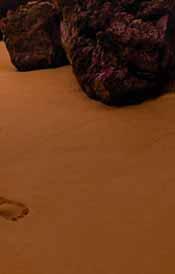




































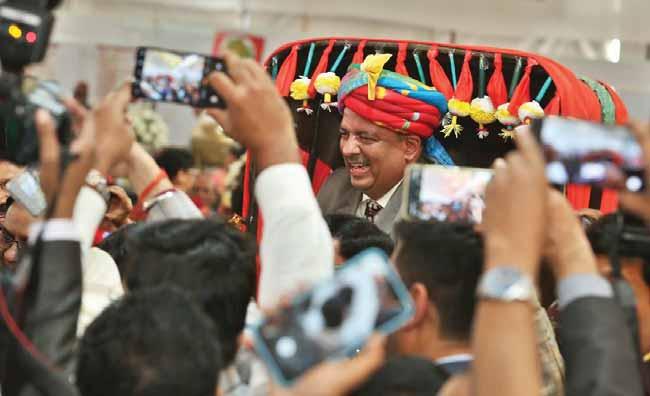
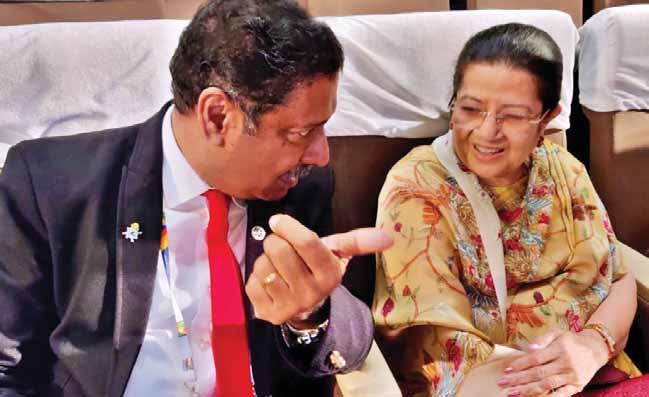
largest TRF benefactors:
10 Rotary India celebrates centennial with service projects worth $300 million
A detailed account of the Centennial celebrations held at Kolkata.
16 Rotary India honours two of its jewels
Rotary leaders acknowledge the rich contribution of PRIPs Rajendra Saboo and Kalyan Banerjee at the Summit.
20 Let’s work for a more diverse & flexible Rotary
President Maloney’s address to the Rotarians at the Kolkata Summit.
24 Honouring generosity
The Centennial Summit recognises two of India’s largest donors to TRF.
40 Business Casual
An interview with RIPE Holger Knaack.
46 A high-level Rotary delegation meets Pak PM on polio
RIPE Holger Knaack and incoming Trustee Chair K R Ravindran show solidarity with polio eradication efforts in Pakistan.
48 District 3060 hosts a star-studded Discon at Goa
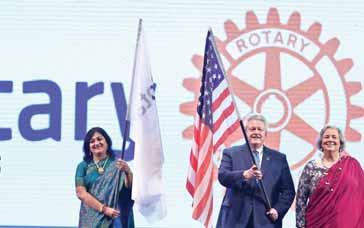



Rotary leaders gathered in strength for lively interaction and fellowship.






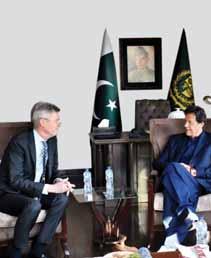
56 Painting Chennai Pink RID 3232 makes women financially independent by giving them autorickshaws.
On the cover: A cultural performance at the Centennial Summit in Kolkata.
Picture: Rasheeda Bhagat
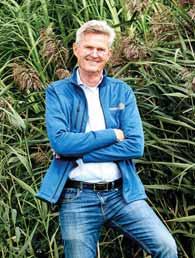








In the Feb issue, the article on RIPE Holger Knaack launching the new presidential theme Rotary Opens Opportunities at the IA 2020 was inspiring. It is a perfect theme for the new Rotary year when Rotary India is celebrating a century of service.
The plethora of opportunities Rotary opens through its five Avenues of Service for club members is huge and we only need to embrace the motto of Service above Self in feelings, thoughts and actions to enrich our experience as Rotarians.
R Murali Krishna RC Berhampur — RID 3262

Therewere several interesting articles in the Feb issue including the one on RIPN Shekhar Mehta where he has urged us to do service projects that reflect 10 per cent of government work. I congratulate the Editor for doing an excellent job in giving us an interesting and informative magazine that includes features on
Trustee Chair-elect K R Ravindran’s views on the new programmes and priorities of the Foundation at the International Assembly were really a motivating. I contribute every year on July 1 a small amount to TRF. Even though it is small, I make it a habit. Sometimes I think how my contribution will support our TRF. But after reading this article, I feel part of TRF’s doing good in the world. I request all those who read Rotary News to do the same and motivate others to do so too. This will enable us to reach our Endowment goal for 2025 with more motivated donors.
Lakshman
Sreedharala RC Anakapalle — RID 3020
noteworthy and inspiring projects done by Rotary clubs.
The Editor’s Note An Institute to remember (Jan issue) was superb and the articles on the Indore Institute were excellent. RI Director Kamal Sanghvi’s promise to hold an “Institute of heart” at Kochi in November is good news to the people of Kerala as well as Rotarians in this region.
Please increase the pages for Letters so that the views of Rotarians from different parts of India can be accommodated; the pictures of senior leaders can be reduced.
Daniel Chittilappilly RC Kaloor — RID 3201
It is amazing to be a part of Rotary India Centennial Summit 2020. I am delighted to be a witness of this event at Kolkata, as this opportunity comes once in a lifetime.
My compliments to Rotary News which is full of colourful pictures and articles on diverse subjects that influence the readers at large. Articles such as Beekeeping to boost Pune farmers’ income, Simple steps to rescue heart attack victims and RC Nagpur plays Santa Claus for mentally-challenged children on its 75 th Charter Day turn the focus on some of the burning issues.
Soumitra Chakraborty, RC Calcutta Innovation — RID 3291
( We accommodate almost all the letters that we receive from our readers after suitable editing: Editor )
Whata nicely compiled Feb issue of Rotary News. The articles Institute honours strongwilled achievers and Simple steps to rescue heart attack victims are informative and helpful. And most valuable was the Project Positive Health campaign with the slogan Ek chammach kum, chaar kadam aage. This campaign will have a great impact on the health of citizens.
Chitranjan Bansal RC Roopnagar — RID 3080
A worthy mag for non-Rotarians too
My compliments to you for turning Rotary News into a highly readable magazine, that even non-Rotarians find it interesting. I like to read first the LBW and Wordsworld columns before going over to other Rotary articles.
In the Jan issue, the feature that you did on the famed street food of Indore was interesting. The book review titled A book for our times by Sandhya Rao in her regular column is very timely and reflects the true philosophy of the Rotary movement. I am pleasantly surprised at the choice of books that you pick up for review.
The two-word mantra of RID Bharat Pandya hope and opportunities is in sync with RIPE Holger Knaack’s theme, Rotary opens opportunities RIPN Shekhar Mehta has shown us an exciting path with his suggestion ‘Let us do service projects that reflect 10 per cent of government work.’ For me, Rotary News , with its wide range of information, is an encyclopaedia and when I read it in Tamil I can appreciate each and every page of the magazine.
Dr Subramanian RC Puliangudi — RID 3212
Ihave been reading Rotary News for the last 47 years, since I joined Rotary in 1972–73. This publication holds a special value in spreading Rotary, informing about many
events of social interest, and encouraging Rotarians and the public to participate in Rotary projects and activities. I was inspired, first to become a Paul Harris Fellow, and later a Major Donor, after reading the magazine, though I am a teacher having a limited monthly income.
I liked the article on RID Bharat Pandya’s views on regionalism and federalism. Regular columns like the one on books, On the racks, Convention Countdown and reporting of club activities and projects such as beekeeping, protective clothing for garbage collectors, and restoration of lakes in Chennai are all interesting.
Madhav Kashalikar RC Sangli Midtown — RID 3170
This also applies to the introductory piece on A Chequered Brilliance by Jairam Ramesh in this issue.
I also like the regular feature Meet Your Governors as it offers readers a good opportunity to get acquainted with the life and work of our district leaders. In a way, it has filled a vacuum. Similarly, the format of Club Matters is pleasing and at the same time bringing out the essence of the diverse work being done by the clubs across the country.
PDG Lalit Surjan — RID 3261
Helpful RI staff at RISAO
It’s heartening to note that RI General Secretary John Hewko has given
instructions to TRF staff that when they review GGs, their role is to get a ‘yes’ and not a ‘no’.
I’ve served as a primary contact for one matching grant and two global grants. I had a pleasant experience in getting approval for all these grants as the applications were processed quickly and the approvals came faster than we expected. The TRF staff at Evanston and RISAO were courteous and helpful. Yes, they sought a few clarifications just as anybody would do before parting with money. Once we addressed their concerns, the approvals came fast. We appreciate their efforts and cooperation. Clubs must state facts
in their GG applications as this will get the job done quickly.
K Ravindrakumar RC Karur — RID 3000
The cover story Suicide is a cry for help (Dec issue) was excellent and an eye-opener. Jaishree has brought into focus the nitty-gritty that create depression, pushing the young to commit suicide. We should all look seriously into the causes and take steps to improve external situations that drive vulnerable youth to take this extreme step.
Payal Agarwal, RC Calcutta Mahanagar — RID 3291
Rejecting beauty stereotypes
Kindly refer your editorial Shattering the ‘beauty myth’… (Dec issue). Your passion to go back to the past is to be admired because only in that way you have unravelled the mystery of the ways of the world, human sentiments and diversity.
Rejecting stereotypes needs a lot of guts and challenges and most of the youth of today is changing its outlook. They have come to understand that beauty is skin deep and not based on colour.
Arun Kumar Dash RC Baripada — RID 3262
We welcome your feedback. Write to the Editor: rotarynews@rosaonline.org; rushbhagat@gmail.com Click on Rotary News Plus in our website www.rotarynewsonline.org to read about more Rotary projects.

Marchis the month we celebrate Rotaract — and this has been quite a year for our young partners in service.
Last spring, the Council on Legislation elevated Rotaract in our constitution: Rotary International is now the association of both Rotary clubs and Rotaract clubs. Then in October, the Rotary Board of Directors eliminated the artificial Rotaract age limit and took other steps to break down barriers that were preventing Rotaract from growing in some parts of the world.
These steps were long overdue, because Rotaract is a vision of what Rotary must become. Not only do we need to open our doors to our young colleagues, but we also have to open our ears and minds to the Rotary experience they find most engaging. That is one of the best ways we will meaningfully grow Rotary.
When I say grow Rotary, I mean it in many ways. We need to grow our service and to grow the impact of our projects. Most importantly, however, we need to grow our membership, so that we can achieve more. Rotaractors provide this opportunity, not only because they can transition to Rotary at the time that is right for them, but also because they understand what it will take to attract others like them.
Business as usual will not work for us anymore. Bringing in more members to replace the ones we lose is not the answer. It is like pouring more water into a bucket full of holes. We need to address the root causes

of member loss in many parts of the world: member engagement that is not what it should be, and our member demographic that skews steadily older.
It is time to make some fundamental changes. We already know what the barriers are to an engaged and diverse membership. It is time to act on what we know: creating new membership models, opening new paths to Rotary membership, and building new Rotary and Rotaract clubs where the existing clubs do not meet a current need.
New club models represent an opportunity to connect with a more diverse group of individuals — particularly those who are unable or unwilling to join our traditional clubs. While new club models have been emerging for some time, it is up to district governors to make them a reality. In January at the International Assembly, our incoming district governors took part in an exercise called Build Your Own Club Model. It was a wonderful experience that put them in the right frame of mind for the work ahead.
Ultimately, however, it will be up to Rotaractors and young Rotarians to create new club models that are most meaningful to the next generation. We may think we know what young people want from Rotary clubs in the future, but I am confident that what young people say will surprise us. It will be our job to support their innovation, for it will help us grow Rotary as Rotary Connects the World.
Mark Daniel Maloney President, Rotary International

ver the last five years, almost all the RI Presidents have told me that no place on earth celebrates Rotary events as colourfully and grandly as Rotarians do in India. Forget a Zone Institute which has so much of colour, music, dance and dazzle, even a district in India celebrates its annual meet with fun and grandeur, some of them in exotic places as the Rann of Kutch or near the Kanha forest.
So if Rotary in India was marking its centennial year, which had to be in Kolkata, as it was here and with the Rotary Club of Calcutta that the organisation made its footprint in India 100 years ago, and the Centennial Committee Chair is Rotary International President Nominee Shekhar Mehta, then the celebration had to be a mega one. And so it was; at the three-day event held at the sprawling Biswa Bangla Convention Centre in the city of joy. Beginning with the RI President Mark Maloney, Trustee Chair Gary Huang, incoming Trustee Chair K R Ravindran, RI directors in such huge numbers that President Maloney quipped that he could have almost planned a Board meet here, a plethora of senior leaders from RI were there. And this included trustees, both incoming directors and trustees, and the entire senior leadership from India, without exception.
The inaugural march of senior leaders at almost all prominent Rotary events in India is grand, but the one at Kolkata was nothing short of spectacular. It was A R Rahman’s mesmerising music all the way — as the senior leaders marched into the House of Friendship — oh yes, this seems to be a precursor to an RI Convention in India sometime in the near future, as Mehta himself indicated — it was the hit number
Marhaba and the words Hindustan meri jaan that reverberated in the sprawling area decked up with cutouts and electronic screens flashing Kolkata’s icons such as the Victoria Memorial, the Howrah Bridge and so on.
But even more impressive than the spectacular opening was the information that RIPN Mehta shared with the 4,000-odd delegates from 32 countries on the mind-blowing work Indian Rotarians have done through community projects, and its dazzling growth in both membership and TRF giving. Membership in India has consistently been growing in the last 10 years and “our membership now stands at 12.07 per cent of world membership,” he said. In TRF giving, India now stood at No 2, having given over $20 million in each of the last three years. Rotaract was thriving in India, which had 24 per cent of the Rotaract clubs and 41 per cent of Rotaract membership in the world. If these numbers are impressive, the work done by Indian Rotarians through community service projects is even better. Here are some numbers to consider: Over the last 10 years, an estimated two million people have got their eyesight at over 200 eye hospitals that Rotarians run in India, and over 20,000 children have undergone heart surgeries, and today they are alive thanks to Rotary. Across India, Rotary runs more than 30 blood banks, and is committed to skill development of 30,000 widows and their children.
Small wonder that Nilima Joshi, past president of RC Calcutta, where the Rotary magic began 100 years ago, says the best part of her year as president was the gratitude and happiness expressed by parents of little kids whose hearts the Rotarians had mended. Nothing could match that sense of satisfaction, she said quietly.
Rasheeda Bhagat
RI Dist 2981
RI Dist 2982
RI Dist 3000
RI Dist 3011
RI Dist 3012
RI Dist 3020
DG N Manimaran
DG Natesan A K
DG Dr A Zameer Pasha
DG Suresh Bhasin
DG Deepak Gupta
DG M Veerabhadra Reddy
RI Dist 3030 DG Rajendra Madhukar Bhamre
RI Dist 3040 DG Dhiran Datta
RI Dist 3053
DG Harish Kumar Gaur
RI Dist 3054 DG Bina Ashish Desai
RI Dist 3060 DG Anish Shah
RI Dist 3070 DG Sunil Nagpal
RI Dist 3080 DG Jitendra Dhingra
RI Dist 3090 DG Rajeev Garg
RI Dist 3100 DG Hari Gupta
RI Dist 3110 DG Kishor Katru
RI Dist 3120 DG Sanjay Agrawal
RI Dist 3131 DG Ravee Dhotre
RI Dist 3132 DG Suhas Laxmanrao Vaidya
RI Dist 3141 DG Harjit Singh Talwar
RI Dist 3142 DG Dr Mohan Chandavarkar
RI Dist 3150 DG Pandi Sivannarayana Rao
RI Dist 3160 DG Nayan S Patil
RI Dist 3170 DG Dr Girish R Masurkar
RI Dist 3181 DG Joseph Mathew
RI Dist 3182 DG Ramesh B N
RI Dist 3190 DG Dr Sameer Hariani
RI Dist 3201 DG R Madhav Chandran
RI Dist 3202 DG A Karthikeyan
RI Dist 3211 DG Shirish Kesavan
RI Dist 3212 DG S Sheik Saleem
RI Dist 3231 DG Sridar Balaraman
RI Dist 3232 DG G Chandramohan
RI Dist 3240 DG Dr Debasish Das
RI Dist 3250 DG Gopal Khemka
RI Dist 3261 DG Ranjeet S Saini
RI Dist 3262 DG Debasish Mishra
RI Dist 3291 DG Ajay Agarwal
Printed by P T Prabhakar at Rasi Graphics Pvt Ltd, 40, Peters Road, Royapettah, Chennai - 600 014, India, and published by P T Prabhakar on behalf of Rotary News Trust from Dugar Towers, 3rd Flr, 34, Marshalls Road, Egmore, Chennai 600 008. Editor: Rasheeda Bhagat.
The views expressed by contributors are not necessarily those of the Editor orTrustees of Rotary News Trust (RNT) or Rotary International (RI). No liability can be accepted for any loss arising from editorial or advertisement content. Contributions –original content – are welcome but the Editor reserves the right to edit for clarity or length. Content can be reproduced, but with permission from RNT.
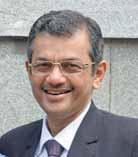
It is truly a momentous occasion for any organisation to complete 100 years. From a tiny beginning with one club and a few Rotarians today Rotary in India has 3,860 clubs and 151,160 Rotarians. Rotary in India initiates and carries out hundreds of humanitarian programmes to provide safe water, proper sanitation, alleviate poverty, promote literacy, improve health and protect the environment. Rotary in India has played a stellar role in making India polio-free.
With the guidance of Rotary senior leaders of our zones, Rotary India has done well in harnessing the strength and dedication of Rotarians and Rotary families. I compliment Rotarians, past and present, in helping build Rotary and for their work for Rotary. A century of service is a good time to reflect upon the achievements of the past and step firmly into the future — a future which is exciting and bright. It’s a great time to be a Rotarian in India.
The Rotary India Centennial Summit brought together over 4,200 Rotarians and families to reflect on the work done in Rotary’s Areas of Focus. Several speakers encouraged, motivated and guided Rotarians to work with consistency and credibility. A well-organised, successful event.
March is Water and Sanitation month. “When the well runs dry we learn the worth of water.” This truism brings sharply into focus the critical importance of water conservation. Water and Sanitation go hand in hand and together they are the key to progress. Under the aegis of Rotary India Water Mission and Rotary India Sanitation Mission, Rotary is taking a lead, collaborating with the government and working to fulfill these two basic needs.
And in March we celebrate the World Rotaract Week. Rotary’s aim is to build a strong, vibrant youth with a sound value system for our nation’s future. I believe that Rotaract is about building leadership skills, learning, unlearning and relearning about the responsibilities that each young person has — to himself and to others — and to imbibe values that could last a lifetime. Working through Rotaract youngsters have the opportunity to embrace change, be the torchbearers of change and ensure a brighter future for our world. I see joint activities between Rotaract and Rotary as a good way forward for both. I can visualise that this is the shape of our future.
As Rotary enters a new era of service in our part of the world, let us rededicate ourselves to the core values and ensure that Rotary Connects the World. Enjoy Rotary Enjoy Yourself.

Dr Bharat Pandya RI Director, 2019–21
Dear Rotarians,

Clean water is a basic need for human beings. Access to clean water ensures healthier and more productive lives. But in India, at least 3,000 children die every day from diseases caused by unsafe water, which is what motivates our members to build wells, install rainwater harvesting systems, and teach community members how to maintain new infrastructure.
While very few people die of thirst, millions die from preventable waterborne diseases, providing us the challenge and opportunity to improve sanitation facilities in undeveloped countries. Members start by providing toilets that flush into a sewer or a safe enclosure and then add education programmes to promote handwashing and other good hygiene habits.
Recognising the urgency and need to address water and sanitation issues, Rotary India, led by RIPN Shekhar Mehta, Director Bharat Pandya and me, has launched two verticals at the recently concluded Rotary India Centennial Summit 2020 — Rotary India Water Mission (RIWM) chaired by PDG Ranjan Dhingra and Rotary India Sanitation Mission (RISM) chaired by PDG Ramesh Aggarwal.
The next five-year-goal for RIWM includes a Water Development Target — construction of 10,000 check dams impacting 500 million acres of land; intensive afforestation by planting five million trees in the vicinity of these waterbodies at an estimated cost of `165 crore.
• Advocacy / Awareness / Activism Target: Touching 500 million lives.
• Transformation / Rejuvenation of water bodies Target: 10,000 large water bodies to be revived on pan-India basis.
• Efficient Rainwater Harvesting (Urban) Target: 50,000 urban rainwater harvesting structures and revival of non-functional RWHS.
• Reduce / Reuse / Respect / Retrieve / Recharge / Recycle of water: Target: 25,000 villages.
The objective is to align RIWM with Jal Shakti Abhiyan, a national mission launched by the Union Ministry of Jal Shakti. The goals for RISM for the next five years include covering 1.5 lakh schools for WASH, MHM, BCC, hygiene education and training. Around 5,000 villages will be made ODF-Plus: Proper toilets, tap water supply and sanitation facilities in homes, schools, healthcare centres, anganwadis, etc.
Friends, let us tighten our belts, the climb is steep, but climbing must be done.

Board of Permanent Trustees & Executive Committee
PRIP Rajendra K Saboo RI Dist 3080
PRIP Kalyan Banerjee RI Dist 3060
RIPN Shekhar Mehta RI Dist 3291
PRID Panduranga Setty RI Dist 3190
PRID Sushil Gupta RI Dist 3011
PRID Ashok Mahajan RI Dist 3141
PRID Yash Pal Das RI Dist 3080
PRID P T Prabhakar RI Dist 3232
PRID Dr Manoj D Desai RI Dist 3060
PRID C Basker RI Dist 3000
TRF Trustee Gulam A Vahanvaty RI Dist 3141
RID Dr Bharat Pandya RI Dist 3141
RID Kamal Sanghvi RI Dist 3250
Executive Committee Members (2019–20)
DG Deepak Gupta RI Dist 3012
Chair – Governors Council
DG Nayan Patil RI Dist 3160
Secretary – Governors Council
DG Dhiran Datta RI Dist 3040
Secretary – Executive Committee
DG Ajay Agarwal RI Dist 3291
Treasurer – Executive Committee
DG Rajendra Madhukar Bhamre RI Dist 3030
Member – Advisory Committee
ROTARY NEWS / ROTARY SAMACHAR
Editor
Rasheeda Bhagat
Senior Assistant Editor Jaishree Padmanabhan
ROTARY NEWS / ROTARY SAMACHAR
ROTARY NEWS TRUST
3rd Floor, Dugar Towers, 34 Marshalls Road, Egmore Chennai 600 008, India. Phone : 044 42145666
e-mail: rotarynews@rosaonline.org Website: www.rotarynewsonline.org
Now share articles from rotarynewsonline.org on WhatsApp.

Rotary India celebrates centennial with service projects worth $300 million

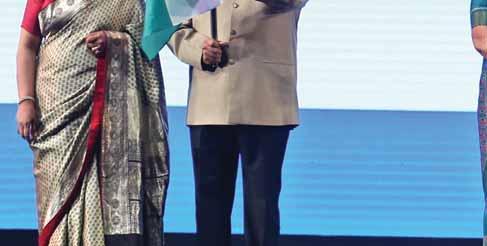



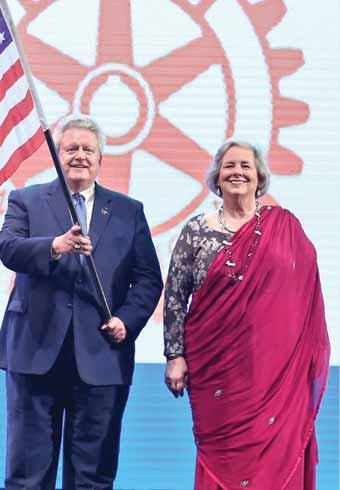
As the centennial celebrations of Rotary India kicked off in Kolkata at the star-studded centennial summit, which saw the participation of some 4,000 delegates from 32 countries, including several present and incoming RI Directors and Trustees, RIPN Shekhar Mehta explained with facts and figures why he calls Rotary India the Kohinoor of Rotary.
“This is truly an epochmaking year for Indian Rotarians; 100 years for any organisation is a momentous occasion and I get goosebumps when I, as Chair of the Centennial Committee, evaluate the service we do. For an organisation, whose motto is Service above Self , the best way to celebrate is to enhance our service activities.”
Indian Rotarians had raised the bar “to make Rotary India the most famous precious gem of the Rotary world” through their membership, Rotaract, programmes and projects, TRF giving and the leadership in India. Buoyed by the success of eradication of polio in 2011 (when India had the last case of polio), Indian Rotarians have taken up major challenges in each area of focus.
“At a time when the growth figures of Rotary are not encouraging, India’s membership is a silver lining. With a growth rate of 44 per cent over the last 10 years, our membership is 12.07 per cent of world membership.” India was poised for a leap in growth, with Indian Rotarians having picked up
the gauntlet and committing to bring one member each in the next 30 months. He had asked this question to over 15,000 Rotarians in the last three months and their response had always been overwhelming.
When he asked the packed hall at the inaugural session if each of them would do so, there was a roar of assent. Said a beaming Mehta: “This commitment is being made in front of the man who wants to ‘grow Rotary’ (President Maloney), which is his clarion call.” Retention too will be high on the agenda of Indian Rotarians, he added.
The RIPN said Rotaract was thriving in India. We have 24 per cent of the Rotaract clubs in India and 41 per cent of the world’s Rotaractors are here. The conversion numbers were encouraging too. “Last week I was in PRIP Kalyan Banerjee’s district (RID 3060) conference, and I saw these former Rotaractors who had gone on to become district governors. In the last 10 years, from RID 3060 seven Rotaractors, four who had been DRRs, have become DGs.”
With the new legislation on Rotaract, Mehta said he was confident that India would not only get more Rotaractors, but many of them would also convert into Rotarians.
“If our membership and Rotaract are strong, our work in serving our communities is even stronger. The work that Indian Rotary clubs and

districts do is unparalleled. To give a perspective, 38 DGs from India, and one from Nepal, have given a commitment to do projects worth over $300 million this year. I have checked every three months if they’d like to revise their targets downwards, and not one has done it. Their commitment is unwavering.”
Addressing the Governor of West Bengal Jagdeep Dhankhar, who was present, he said over the last 10 years, “two million people have got their eyesight at over 200 eye hospitals that we run in India. If one child gets a hole in the heart in our family, our world turns upside down. Over the last 10 years more than 20,000 children have undergone heart surgeries, and today they are alive because of the “gift of life” that Rotary has given them.”
Across India, Rotary runs more than 30 blood banks, and is committed
to skill development of 30,000 widows and their children and of this, 20 per cent has already been accomplished.
“We have provided 25,000 shelter kits benefitting 125,000 people; and gave dignity to 100,000 people by constructing 20,000 rural toilets. We have set up over 25,000 E-learning units, improving the learning experience of 7.5 million students.
More than 70,000 teachers have been trained and felicitated for the work they do.
“Over 85,000 adults have been given dignity because we made them literate and it is little children who are making these adults literate. In India, if we try to send the child of a beggar back to school, it’s a tough task. Try and send the daughter of a sex worker to school, it’s an extremely tough task. But Rotarians in India have sent back to school over 50,000 children,” he added.
It is pouring Arch Klumph Society members in India; we
have the second highest number of AKS members in the world.
RIPN Shekhar Mehta
Indian Rotarians have built libraries and more than 2,500 schools have been totally renovated and converted into Happy Schools benefitting 75,000 students . “Our programmes now span the length and breadth of the country and we work with both state and central governments.”
Coming to Literacy, Mehta said the Rotary India Literacy story was
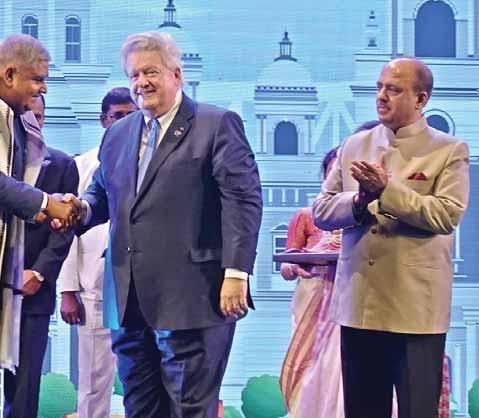
“unparalleled; there isn’t a more holistic programme of total literacy by any other organisation than the one Rotary has in India.” Rotarians were working in tandem with the government and several State governments had invited Rotary to work with them in their States. “We have worked in 30,000 schools benefitting more than 100 million children. Working with the government, we are committed to making India totally literate by 2025, a dream that was given to us by PRIP Banerjee.”
In both healthcare and WASH, Indian Rotarians had laid down “some ambitious targets; such is the determination of the Rotarians that last week, when I met the President of India and the Home Minister, I have given them in writing that Rotary is committed to doing 10 per cent of the work the government is doing in selected areas.”
He could make this commitment because in certain selected areas, Rotarians were already doing this. In water and sanitation, they were committed to revitalising 10,000 water bodies out of a government target of 100,000 water bodies, and setting up 10,000 check dams against a government target of 100,000. “Friends, these are stretch goals, but then so was polio.” During NIDs, even today, a huge number of Rotarians volunteer their time for polio eradication by going out and giving drops so that no child is missed out.
“Our contribution to TRF is another reason for India to be the Kohinoor of Rotary. For the last three years we have consistently been the second highest giver to TRF… giving $22 million a year.” With the US dollar hovering around `70, the equivalent in Indian rupees comes to a staggering `1,500 crore a year
Over the last 10 years more than 20,000 children have undergone heart surgeries, and today they are alive because of the “gift of life” that Rotary has given them.
RIPN Shekhar Mehta
“It is pouring Arch Klumph Society members in India; we have the second highest number of AKS members in the world; we are second only to big brother USA. And we have the highest number of endowments. We have here with us the new poster boy of giving in the Rotary world — Ravishankar Dakoju. This one man has committed a whopping `100 crore.”
Mehta said Rotary India had the best leadership in the world. “At the age of 86, PRIP Rajendra Saboo is leading medical missions to Africa, not once or twice but at times even three times a year. PRIP Kalyan Banerjee not only dreams for a totally literate India but works for it and is ready to do anything, go anywhere required, to achieve that goal. Past Director Sushil Gupta is known as the WASH man of Rotary in India; if there is a natural disaster, the man who can turn rubble into rubies is PRID Yashpal Das.
“If you need money for a good cause, you just need to ring up PRID Ashok Mahajan, PRID P T Prabhakar has done some outstanding work in WinS; PRID Manoj Desai has used his vocation as an orthopaedic surgeon to do hundreds of corrective surgeries

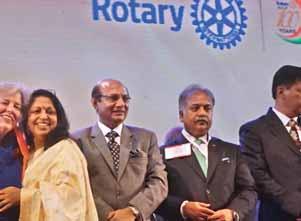


for polio-afflicted. Today we sorely miss PRIDs Sudarshan Agarwal and O P Vaish. PRID C Basker, Trustee Gulam Vahanvaty, RI Directors Kamal Sanghvi and Bharat Pandya have provided outstanding leadership as representatives from India on the RI Board and our Foundation.”
While the senior leaders from India were ‘the lighthouses”, the leadership skills of hundreds of past governors and thousands of Rotarians, “each of them eager to bring a smile on the faces of our countrymen, are exemplary. No wonder our Rotary dreams are big, and we will try to make them into reality.”
In conclusion, Mehta thanked the delegates and said: “Never before in a voluntary event, so many senior leaders have turned up. We want to have a larger number, and hopefully that will be at a Rotary Convention in Delhi in the near future.”
Convener of the meet Kamal Sanghvi said the organisers were “overwhelmed” at the presence of Rotary leaders and delegates from 32 countries, and to honour their presence, their flags were displayed on the stage.
The size and complexity of global challenges need changemakers of every shape and size. Let us resolve once again here to leave our world a better place than we found it.
RI Director Kamal Sanghvi
“We all live in a rapidly transforming and an increasingly interconnected world. The size and complexity of global challenges need changemakers of every shape and size,” he said and dedicated the centennial summit to all the “changemakers in this audience, whose combined courageous action focuses on and benefits our communities. Let us resolve once again here to leave our world a better place than we found it.”
Welcoming the gathering Summit Chair Vinod Bansal urged the
delegates “to use this occasion to rededicate ourselves to the cause of community welfare, be more representative of a diverse world, more effective in our service to humanity and to showcase Rotary’s ethos and culture as a compassionate and humane body.”
At the Centennial Summit in Kolkata, RIPN Shekhar Mehta threw a gauntlet at Indian Rotarians — do service projects in other countries. Having planned and executed thousands of service projects in India, “we have matured as a player in the international service arena and we want to share our resources and talent with other countries. Next year, of the total grants we do in India, we want to do five per cent with other countries, and 10 per cent the following year. India now wants to play its part proactively and responsibly in the growth of Rotary across the world,” he added.
Designed by N Krishnamurthy





PRIPs Rajendra Saboo and Kalyan Banerjee.
It was a poignant moment in the packed hall at the Biswa Bangla Convention Centre in Kolkata where Rotary’s centennial in India was being celebrated through a mammoth conference attended by over 4,000 delegates from 32 countries. Past RI Presidents Rajendra Saboo and Kalyan Banerjee were being recognised and felicitated for their contribution to Rotary in India.
Introducing Saboo, past RI President and incoming Trustee Chair K R Ravindran said as RI President “he made the presidency look tall”, and as RI Director, was responsible for bringing an RI office to our region. “As his governor, I was transformed into the magical world of Rotary.” As Trustee Chair, it was Saboo’s idea to set up peace centres and thanks to this idea “we now have six Rotary Peace Centres in partnership with several leading universities. This has become one of our flagship programmes.”
But Saboo’s “biggest efforts came after he laid down office as Rotary President and in the last 20 years, he has led over 30 medical missions to African countries.”
But, added Ravindran, “when I talk about Raja there is no Raja without Usha; she is a force and an icon in her own
right. I have listened to her at Rotary Convention and IA, and if Raja is a jewel in the crown of Rotary India, or the Raja of Rotary, then to my mind Usha Saboo is the Mother Teresa and a nightingale (because of the service she does in the medical missions as a waiter, nurse, counsellor, mother) of Indian Rotary.”
Accepting the recognition and award in “humility”, PRIP Saboo had a simple message to deliver. “Rotary is my teacher. It gave me the ability to look within me and look beyond myself. I was a self-centered individual… thinking of my business, my family and my ambitions. Rotary had not entered into me then.”
But once Rotary had opened its door for him, he became more than just an Indian; “I became a citizen of the world. My vision enlarged, got tempered and I started to understand the meaning of humanity. When a Pakistan boy, Tausef, after a successful heart surgery under my Rotary club’s project, said, “I can now say one country gave me birth, the other gave me life. Both countries belong to me. Hail Pakistan, hail India, hail Rotary”, Rotary was teaching me a lesson.”
During polio immunisation, when he holds “a little girl with shabby clothes and a running nose

Rotary is my teacher. It gave me the ability to look within me and look beyond myself. I was a selfcentered individual… thinking of my business, my family and my ambitions. Rotary made me a citizen of the world.
PRIP Rajendra Saboo
and administer polio drops in her mouth, knowing these precious drops will overcome the dangers of a paralytic life for that little girl, I get another lesson from Rotary.”
Saboo said when he goes to African countries on medical missions, he learns that the colour of blood is red, be it Indian or African. A few years ago, when a 2-year-old Nigerian girl wouldn’t leave his lap, as he tried to put her on the operation table for surgery, he saw in her face the face of his granddaughter; “Rotary then taught me the meaning of empathy.”
When his business was in trouble and “I had to part with the factory I had built brick by brick, people started wondering what would Saboo’s identity be now. I did not suffer at all. I had learnt the Rotary lesson of ethics and integrity and practised it. It became our family brand. Rotary’s gift to me again.”
He could give other examples of “umpteen personal experiences that changed my life, thanks to Rotary. A best cut diamond does not shine in darkness. Only when light is on it, the diamond’s brilliance determines its value. We may all be diamonds, but only when Rotary’s light falls on us, we realise our value.”
Thanking RIPN Shekhar Mehta, the Chair of the Centennial Celebrations Committee, Saboo added: “I recognise here Rotary as my teacher, my mentor, my lifeline.”
Introducing PRIP Kalyan Banerjee, PRID Manoj Desai related a “fairy tale of a brilliant young chemical engineer from IIT, who was not well in Calcutta, where he met and fell in love with a pretty nurse (Binota). They decided to get married and settle down in Vapi, a
I rather like the term Rotary India. We are now truly on our way to make Rotary explode into the 21st Century, a year when the youth shall truly inherit the world. This is the age of Malala Yusufzai who promotes literacy and Greta Thunberg, who is
PRIP Kalyan Banerjee
small town in Gujarat. The man had his dreams, and the charming wife offered him smiling and rock-solid support. He wanted to start humanitarian projects, and he started doing so in his hometown Vapi.”
The result is that today you can barely come across a school, college or hospital in Vapi that does not bear prominently the logo of the Rotary wheel.
“Next, Banerjee went 150 km away from Vapi to the jungle of Dang, where the tribal people could not afford even two square meals a day. He went there and brought about a lasting change exactly the way our Vision Statement defines. He continues his journey and has reached within to embrace humanity (Banerjee’s theme during his presidential year.)”
Desai added that the hero of his fairy tale was “a man of few words… a man who has the unique ability to find beauty in other people’s faults. He doesn’t become angry but finds beauty in their faults.”
“Sharmishtha and I have known him for 25 years. He is a legend… a man of high principles, sound judgement, great organisational capacity, and an outstanding leader.”
Accompanied by spouse Binota, Banerjee said, “We are overwhelmed at the honour you do us today, as a Jewel of Rotary India, along with my elder brother in Rotary, Past President Raja Saboo. On this happy occasion, I believe that our first Jewel of India, Past President Nitish Laharry, also from Kolkata, like the two of us, must be blessing this occasion with a smile from wherever he may be, up there.”
This honour, he added, went to the entire Rotary family in India, as a “jewel of Rotary International. I rather like the term ‘Rotary India’ for several reasons; the first being that we in India come from a culture that encompasses everything that Rotary is about. A culture that embraces all faiths and every religious belief, just as we do too in Rotary. The Indian culture represents faiths that love all people, in India as also the whole world — just as Rotary does.”
Just as Rotary, Indians believe in what the Sanskrit phrase — Vasudhaiva Kutumbakam — puts it succinctly… that the whole world is but one large family. “We also believe in Nishkama Karma — working without desire — as also in doing our work/service without expecting any benefits. Isn’t that just what Rotary does too? That’s why I truly believe that Rotary is India and India is Rotary.”
Banerjee said he also loved the phrase, Rotary India, because India believed in living together in larger families, “sharing our joys and our happiness”.
And the final reason for his happiness with ‘Rotary India’ was that “we are now truly on our way to make Rotary explode into the 21st century, a year when the youth shall truly inherit the world. This is the age of Malala Yusufzai who promotes literacy and Greta Thunberg who champions environmental issues — they and their likes shall run the world tomorrow.”
India, added Banerjee, has always been one of the strongest proponents of Rotaract. “We may be

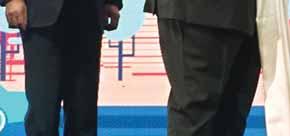

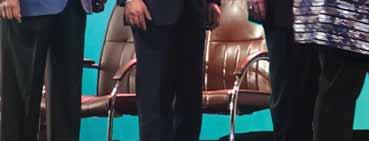




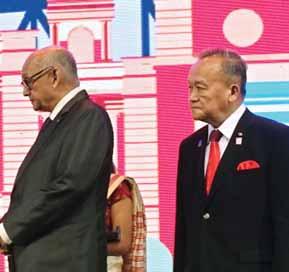

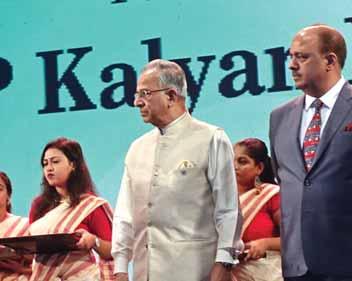
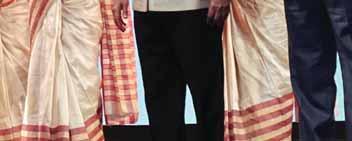



the only country in the world today with a quarterly Rotaract magazine called Rotaract News.”
Senior Rotarians in India have always wanted their children to join Rotaract first and then Rotary.
“That’s really extending our reach. It’s so exciting today to see the Rotary world beginning to go the Rotaract way. That’s a great way to build Rotary’s future and the world’s future too.”
While past RI President D K Lee, handed over the award to PRIP Saboo, Trustee Chair Gary Huang did the honours for PRIP Banerjee.
Pictures by Rasheeda Bhagat
Rasheeda Bhagat
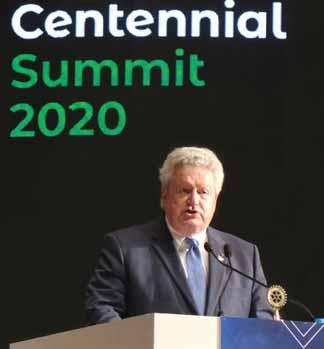
It was with a sense of awe that Mark Maloney delivered his presidential speech at the Rotary India Centennial summit in Kolkata. “It seems just like last week that Rotary celebrated its 100 th anniversary in Chicago. But it was actually 15 years ago. How many of you were there at the Chicago Convention in 2005? Quite a few, I can see. That small club in Chicago started 115 years
ago with just four members; a club so small that today it would not even qualify for a club charter from Evanston!”
And now Rotary Club of Calcutta was celebrating its 100 years, having been chartered on Jan1, 1920. “And soon afterwards, the Marco Polo of Rotary, Jim Davidson, took it upon himself to further expand Rotary’s reach in India.” Davidson travelled 240,000 km in two years, “travelling by
steam train and car, canoe and elephant, arriving in Bombay in Feb 1929 with his wife and daughter, intending to start a club there. But it was not an easy task to start a club in this big city of 1.2 million people. Wouldn’t Davidson be amazed to know that Bombay now has a population of more than 18 million?”
Maloney recalled how three attempts to start a Rotary club in Bombay had failed prior to his arrival, but in March that year, Davidson successfully organised a club that would receive its charter on May 8. Next, he organised a club in Delhi, before visiting Rotarians in Calcutta, when N C Laharry was serving as club secretary. “Laharry as you all know, went on to become RI President in 1962–63. It brings me to the most important story of Rotary in India. And that is not your past but your future.” Come July 1, 2021, and Shekhar Mehta would become the fourth Rotary President from
India. “I am delighted to be working with Shekhar as part of Rotary’s leadership team. His steadfast efforts at Rotary service projects makes him the perfect person to not only represent India in Rotary leadership but also to point us towards a future with more members and greater impact across the world.”
Looking back at Rotary’s 100 years in India and looking forward to “India’s growing importance in our organisation, we can reflect on the importance each act of goodness in the world that we have all done together. And how those acts add up and change us,” said Maloney. Sometimes, individual acts of service can seem insignificant in the context of all the needs we have in the world.
“But when you multiply all those acts done by all those Rotarians over years and then add them together with the tens of thousands of Rotary clubs around the world, you realise the kind of impact
that every one of us can make when we join a Rotary club and decide to commit to service as a way of life.”
In less than a year Mehta would be picking a theme; a phrase that will translate well, will be short enough to fit easily on a banner and one that will not violate any copyright. Above all, “a theme that will speak and motivate Rotarians in many different countries.”
The RI President was happy to note that more than one in five Rotarians is now a woman and “we will continue to move towards our 50:50 goal in the years ahead. But we
We need to grow Rotary by getting men and women of diverse backgrounds, who are willing not only to join us but also to serve.
need to grow Rotary by getting men and women of diverse backgrounds, who are willing not only to join us but also to serve.”
It was important to understand that Rotary has never been a one-size-fits-all organisation and “if
we have to continue to grow, we cannot allow it to become one; for this both flexibility in our clubs as well as diversity in membership are important. Some clubs might still prefer their traditional lunch meeting. But we need to remain open to the possibility of
new clubs doing things in new ways to meet the needs of their members.
Rotary opens doors to new friendships, opportunities and experiences.”
But Rotary service was not a one-way street “in which we only do good to others. There is a tremendous amount of personal development that can come from being a Rotarian… whether it is learning how to hold a meeting, manage a project, speak in public or anything else. There is so much to explore in Rotary and the more you explore the better will be your experience in Rotary membership.”
Picture by V Muthukumaran
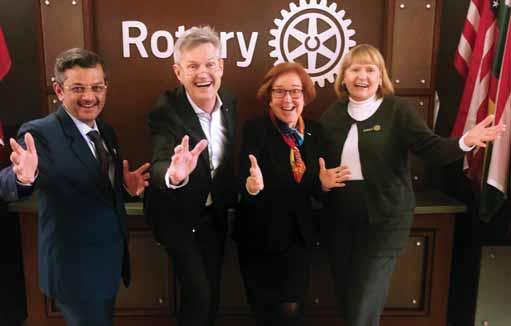
RI Director Bharat Pandya is Treasurer of Rotary International for 2020–21, when Holger Knaack will be RI President.
RID Johrita Solari will be the Vice President and RID Stephanie Urchick, the Executive Committee Chair.

From L: RI Director Bharat Pandya, RIPE Holger Knaack, RIDs Johrita Solari and Stephanie Urchick.
V Muthukumaran
Just creating sanitation infrastructure in villages and schools alone will not bring the desired results, rather we must focus on building local capacity, engage the beneficiaries and stakeholders, recruit professional managers and change social behaviour among target groups by roping in social entrepreneurs, said PDG Ron Denham, Chair Emeritus, Water and Sanitation Rotarian Action Group (WASRAG).
Speaking at the session on ‘Providing Clean Water’ at the Centenary Summit in Kolkata, he said WASRAG is helping local communities to take ownership of water and sanitation facilities by making them ‘partners in execution’. In the last five years, the Foundation has implemented WASH projects worth $113 million across the world. “Rotary has done 316 global grant programmes on water and sanitation at an investment of $23 million and individual projects worth
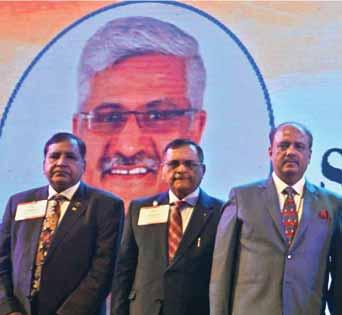
$250,000 in Indian zones. WASRAG helps clubs in drafting proposals for global grant funding and offers a compendium of best practices for executing clubs,” he said.
In his presentation, PDG Ranjan Dhingra, Chairman, RI Water Mission (RIWM), recalled the Delhi Declaration 2003 after a presidential conclave which led to the formation of RI Water Conservation Trust in the next year. “So far, we have built over 110 check dams in Rajasthan, Haryana and
Punjab benefitting 5,000 people. We hope to do at least 10 per cent of the government projects under this holistic programmes of RIWM,” he said. By 2025, RIWM plans to build 10,000 check dams; revive and rejuvenate 10,000 waterbodies; and 50,000 urban RWH structures at `50 crore.
On a larger scale, Rotary India has drawn up plans to make 250,000 villages self-sustained communities (net zero) at an estimated cost of `25 crore and will take
From L: PDGs Ramesh Aggarwal, Ranjan Dhingra, RIPN Shekhar Mehta, PRID Y P Das, Union Minister of Jal Shakti Gajendra Singh Shekhawat, PRID P T Prabhakar, PRIP Kalyan Banerjee, DG Harish Gaur and TRF Trustee Gulam Vahanvaty.
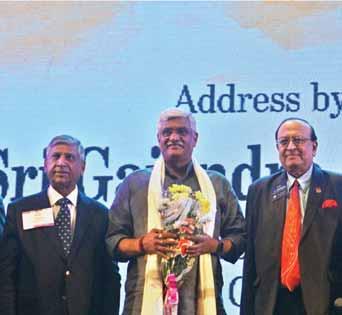




PRID P T Prabhakar felicitates Magsaysay awardee Rajendra Singh in the presence of Centennial Summit Secretary Kishore Kumar Cherukumalli, PRID Jackson Hsieh and RID Francesco Arezzo.
up advocacy campaigns to touch 50 crore lives across the country at an estimate of `2.5 crore. “The sanitation coverage under the Swachh Bharat Abhiyan which stood at 39 per cent rose to 99 per cent as on June 2019 covering six lakh villages in 700 revenue districts,” said PDG Ramesh Aggarwal, Chair, RI Sanitation Mission. He said Rotary is forming

alliance with UNICEF, World Vision, Sulabh International and other agencies, besides working closely with the Union Ministry of Jal Shakti, to achieve its goals.
Magsaysay awardee and water conservationist Rajendra Singh said nowhere on earth was the groundwater decline greater than in North India where NASA images have shown that largescale irrigation
RI Water & Sanitation Mission’s target 2025
WinS in 100,000 schools
5,000 ODF-plus villages
1,000 villages with tapped water connections under the Jal Jeevan Mission
500 community toilets in villages
500 public toilet blocks in cities for use by floating population
500 WASH projects for hospitals
and exploitation has led to drastic alteration of the topography. He pointed out that indigenous methods were efficient in reversing climate change and even micro clouds were formed over the restored waterbodies.
Union Minister of Jal Shakti Gajendra Singh Shekhawat said, “While 89 per cent of water resources are used for agriculture, the balance 11 per cent is consumed for industrial and household needs. We need to conserve and recycle water to meet the shortfall for which we need a mindset change among people.”
Chairing the session, PRID P T Prabhakar, Global Chair, WASH in Schools Target Challenge Committee and Advisor, Rotary India Water and Sanitation Committee, said to continue with the WinS success story, RIPN Shekhar Mehta, in consultation with RIDs Bharat Pandya and Kamal Sanghvi, has formed Rotary India’s Water and Sanitation Mission (RIWSM) which will support the Swachh Bharat and Jal Shakti Missions of the GoI.
Pictures by Jaishree
Two of TRF’s largest individual donors, both from India, were felicitated at the Centennial Summit in Kolkata for their magnanimity in giving.
Rajashree Birla, the Chairperson of the Aditya Birla Foundation for Community Initiatives and Rural Development, has been an integral part of Rotary India and the second largest individual contributor to The Rotary Foundation, after Ravishankar Dakoju, past president of RC Bangalore Orchards, who made waves with his generous giving of `100 crore to the Foundation last year.
Rajashree’s contribution to TRF has crossed over $12 million. She was
honoured with the Angel of Benevolence Award at the Summit.
“Giving and caring epitomises the ethos of Rotarians, regardless of geographical boundaries. It is an aspect embedded in the DNA of the Birla family too,” said Rajashree in her acceptance speech. In fact, the philosophy of giving goes back to 150 years ago “when my great grandfathers-in-law Shiv Narayan Birla and Raja Baldev Das Birla felt that in life one must have a higher purpose that goes beyond oneself. In their own way they supported the causes of education, building temples and goshalas.”
Her grandfather-in-law G D Birla was a close confidante of Mahatma

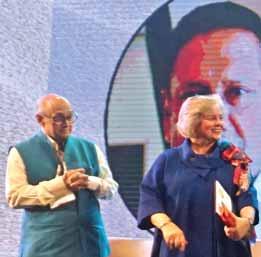
Gandhi. Her son Kumar Mangalam refers to giving as ‘compassionate capital’, she said, and recalled her husband Aditya Birla’s statement: ‘It is in giving that we receive.’
The Aditya Birla Centre is engaged in the development of 7,000 villages and reaches out to nine million people through projects in healthcare, education, sustainable livelihood and infrastructure.
“Giving in my vocabulary means offering whatever you have — be it your affection, emotional support, time and financial help, absolutely and
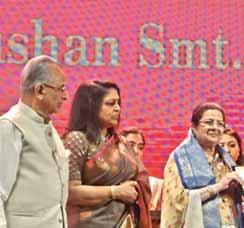




unconditionally, beyond boundaries. ‘Have a heart’ is one of the most commonly used phrases. It is an emotional metaphor for caring and compassion. Heart melts the mind and body with its splendid qualities such as duty, sacrifice, devotion and giving. So have a larger heart and enjoy the joy of giving wholeheartedly,” she said, amidst thunderous applause and a standing ovation.
Rajashree congratulated Rotary India for its centennial and “unmatched


commitment and dedication to its service projects. I have experienced at very close quarters the awesome work that RI is doing in life-changing projects in addressing diseases like polio, thalassaemia, diabetes and tuberculosis,” she said.
The session was chaired by PRID Ashok Mahajan who has played a leading role in bringing the Muslim community on board by forming the Rotary Ulema Council when there was a lot of resistance against polio vaccination in the community.
Mahajan thanked the government, Rotarians and volunteers for making India polio-free. “What better gift this world could expect from us as we immunise over 2 billion children world over by spending $2.5 billion and an estimated 18 million children who we have saved,” he said.
Ravishankar was recognised for his mammoth contribution to the Foundation. “As important as his contribution is, Ravi has taken on the role as TRF’s ambassador and has inspired several Rotarians,
not only in India, but also in Nepal, Taiwan and Brazil, to donate generously to the Foundation,” said Session Chair and TRF Trustee Gulam Vahanvaty. He recalled how, during the installation of DG Deepak Gupta in Delhi, a donor made an impromptu announcement to become an AKS member, presenting cheque for $100,000 for TRF. She was solely impressed by Ravishankar and his wife Paola. “More importantly I was happy to meet this person who was very down-to-earth, humble, warm and affectionate. His wife Paola and he are equal partners in the Ravishankar and Paola Endowment Fund,” he said.
India, with more than 100 AKS members, ranks second in the world after the US and at the Centennial Summit, Vahanvaty announced that an AKS Association is being formed to recognise the philanthropy of their generosity and inspire more people to give to the Foundation.
Pictures by Jaishree
The complex culture, faiths and beliefs of India and its unity in diversity, recent events notwithstanding, was displayed beautifully at the Interfaith Service as the Rotary Indian Centennial Celebrations kicked off in Kolkata. In a beautiful and dignified session, prayers were recited and short intros given to all the religions that form the composite faith fabric of India. While Sikhism took the floor we got to hear an interesting nugget. Apparently famous Hindi cinema veteran Balraj Sahni once asked
Rabindranath Tagore that you’ve composed a great national anthem for India in the Jana gana mana, now why don’t you compose one for the entire world? And Tagore said: “But Guru Govind has already done that by his composition ‘Aarti’ in 1506, which is a song of unity.”
The reference was to Guru Nanak’s spontaneous composition of the Aarti as he stood in the Puri temple, in reverence to the “ultimate creator” whose glory, he said, could not be contained in anything humans had to offer. The gist of
RI President Mark Maloney and Gay dance to Bollywood music. Rashi Mehta is also seen on Gay’s right.
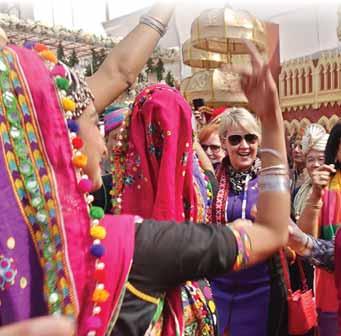
the Aarti is that the creator’s grandeur is too much to be sung with a small set of lamps and incense; the sky itself is the grand platter, the stars are the lamps, the wind is the celestial fan and the flowerfilled forests are the scent.
heady
It was as though the entire City of Joy reverberated to A R Rahman’s famous composition for the Bollywood film Jodha Akbar, as the delegation of senior Rotary International leaders led
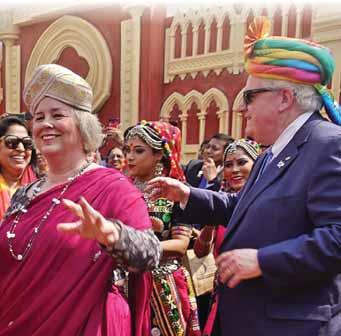



by RI President Mark Maloney and Gay; Trustee Chair Gary Huang and Corinna; RIPN Shekhar Mehta and Rashi; two serving RI directors and their spouses; and TRF Trustee from India; and several serving RI Directors and Trustees from other countries, wearing colourful headgear, marched to the regal tunes of the peppy melody Marhaba (which means welcome).
As the leaders slowly made their way to the House of Friendship, what rang out and resonated was “Hindustan meri jaan”. And after the inauguration of the sprawling House of Friendship where some 100-odd colourful booths had been put together, another Rahman immortal ‘Jai ho’ was played, and it had several RI Directors from overseas including Julia Phelps and Stephanie Urchick jiving to the song in typical Bollywood moves, which were ably demonstrated to the overseas guests by PDG Pinky Patel.
Gay Maloney is by now of course an Indian veteran, and sports the saree with both grace and ease. A terrific sport, as the grand march made its way to the House of Friendship, she

PDGs Zamin Hussain and Shahul Hamid.
spontaneously joined the dancers who were there to welcome the VIPs. And President Maloney followed her. Surely it was a memorable Valentine’s Day for Rotary’s first couple… colourful gear and Bollywood dance. Romance doesn’t come better than that!
That PRID Sushil Gupta, who is battling a health setback, was missed at
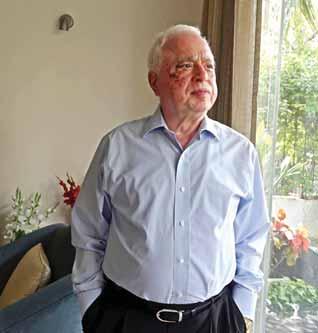

the Kolkata centennial celebrations, was articulated poignantly by none less than RI President Mark Maloney in his opening speech.
Before beginning his address of felicitations, Maloney said: “I would like to recall a dedicated Rotarian who would have really liked to be here today. And I am talking about past director Sushil Gupta.”
He recalled how in 2018, Gay and he had the privilege to welcome Sushil Gupta and Vinita “when they arrived at the Rotary International headquarters in Evanston as he took on the role of RIPN. Of course his health has not allowed him to continue in that position.”
He disclosed that the couple had taken the opportunity, as they travelled to Kolkata through Delhi, to “visit Sushil and Vinita in their home and have a conversation with them about Rotary and life. Sushil is still absolutely dedicated to Rotary. Even though he could not speak with his voice we had a conversation about the wonders of Rotary, the success of Rotary in India. We are delighted we had this wonderful opportunity and he sends his greetings to all the Rotarians who are here in Kolkata.”
V Muthukumaran
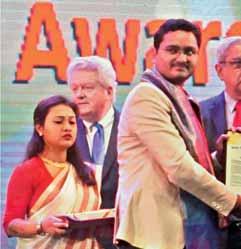

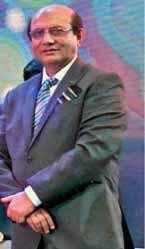
On Valentine’s Day four non-Rotarians were feted with Rotary India Humanity Hero Awards for their selfless work for humanity at the three-day Rotary Centennial Summit in Kolkata. More notably, the awardees were chosen through an online poll which received eight million votes over 45 days for 253 online applicants. “Rotarians speak different languages, but the language of love connects all the 1.2 million members of Rotary. On V-Day, we are recognising people who speak that same language with their selfless service and hope this award will motivate others to excel in service activities,” said the Session Chair RI Director Nominee A S Venkatesh. RIHH Awards Chair PDG Bal Krishna Inamdar said the awards were given to non-Rotarians who had done some outstanding work in healthcare; basic education
and literacy; water, sanitation and hygiene; and economic and community development. A sevenmember jury panel evaluated the final shortlisted 15 aspirants after the online voting which ended on Feb 6.
Deloitte India former Chairman P R Ramesh, a jury member, said that the parameters for the selection of the awards included those working in difficult, dangerous and vulnerable geographic areas; being targeted for




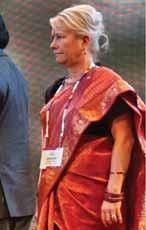
their work; those who strive on despite lack of resources; and those who make optimum use of available funds.
The key to the selection process was to look out for ‘unsung heroes of India’ and by rewarding them, motivate others to replicate their envious feat, said Sanjay Jain, Additional Solicitor General of India, another jury member. Here are the winners and their notable achievements:
1. Bhrigu Borthakur won the award for his work in literacy. He has done extensive flood-relief work in Assam and as an engineering student, took informal classes for children in
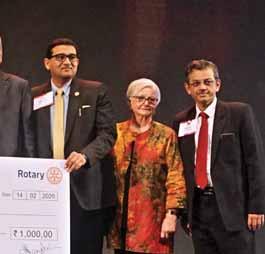
Kudrat. He now runs 13 schools for the benefit of marginalised families. “It is an honour to receive the Rotary award for the work I do at the grassroots level. But special efforts are needed to make the disabled specially-abled, and Rotary is doing just that,” he said in his acceptance speech.
2. Adhik Kadam: A former Rotaractor, he was captured 19 times by terrorists and ultras in Kashmir for trying to rehabilitate misguided youth and making efforts to put them into mainstream society in the remote areas of J&K. Under the banner of Borderless World Foundation, he has rescued over 750 Kashmiri girls and 25 locals who were taken captive by terrorists for brainwashing sessions and then inducting them as militants to work against the Indian Army.
“I am living in Kashmir for the last 23 years since my student days. After seeing the mindless violence, I decided to stay put here and rehabilitate girl children by weaning them away from the influence of militants. Rotary must help in ushering in peace in this Himalayan community,” he said.
3. Swapnil Gawande: It was a great shock for an 8-year-old boy when
he lost his close friend to corneal blindness and since then, he took up a vigorous campaign against this preventable loss of vision. Through his NGO Deesha, he is executing various programmes against eye disorders over the last 15 years in Mumbai. A mechanical engineer with an MBA degree, he has started the Deesha Netralaya Eye Research Institute. “I dedicate this Rotary award to all those who donated the eyes of their deceased kin when the family was in sorrow,” he said. Deesha runs eye banks and a group of schools. Gawande is also an avid promoter of organ donation.
4. Dr Shalini Saxena: As community development officer, she has worked extensively with the female victims of Bhopal gas tragedy. Through her NGO, Priyanshi Educational and Cultural Society, she had created a contraption to make sanitary pads and trained women in making and selling these pads over the last 10 years. Now she has expanded her work to women’s groups in Rajasthan and tribals in Chhattisgarh and Arunachal Pradesh who are being trained on menstrual hygiene issues. Each awardee received a citation and a cash prize of `1 lakh. Pictures by Jaishree
Rasheeda Bhagat
On the inaugural day, following a nicely done interfaith service, leading a grand march, RI President Mark Maloney inaugurated the House of Friendship, headed by PDG V Raja Sreenivasan, in a colourful ceremony with music, dance, and all the senior Indian and international leaders dressed in colourful, traditional Indian pagdis
The HoF, with over 110 stalls, and the colourful adda, put up in a sprawling space within the Biswa Bangla Convention Centre, replete and resplendent with lifesize cut-outs of senior RI and Indian leaders, was buzzing with activity on all the three days. Bearing images of famous Kolkata icons such as the Howrah Bridge, the Victoria Memorial etc, it gave India’s


RID Kamal Sanghvi, Gay, RI President Mark Maloney, Trustee Chair Gary Huang and RIPN Shekhar Mehta inaugurating the HOF.
picture-loving Rotarians enough scope for selfies and group photos.
The food stalls, which had delicacies ranging from Kolkata’s famous puchkas (pani puri) and other chaat to South Indian staples such as the dosai, and a variety of the city’s famous fingerlicking street food, at affordable rates — you could get a delicious satiating meal for around `200 — were a big hit. My favourite stall, to which I kept returning, was the one dishing out chicken egg rolls at a staggering pace. Costing between `100 and `130, it had on offer delicious and juicy chicken rolls made at a live counter, complete with veggies, and a tangy sauce.

It was so popular that many a time you had to push and shove, or get pushed and shoved, in order to get one! But it was
worth fighting for! More precious than the tingling taste buds was the tip you picked up to get the egg coating, always a tricky bit, right on the roti/paratha A confession to make — I even picked up an extra one on two days, and even though stone cold, it made the perfect midnight snack in the room, as I banged away at the keypad, sleepy and tired. And yes, it woke me up!
A nice touch from the organisers was the water bottles — and small ones at that, so that this precious commodity was not wasted — were available free of cost. And there were servers going around carrying water bottles, and clearing the used ones, in large circular trays. In which part of the world do you get service like this? Full marks to the person who thought of adding this gesture.
HoF Committee Co-chair PDG V Raja Seenivasan (centre) with RIDE Valerie Wafer, Summit Chair Vinod Bansal, RID Francesco Arezzo and other delegates.
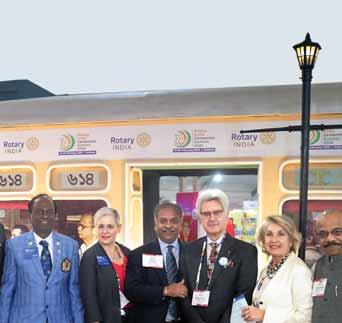


Minister Harsh Vardhan, Rtn Sue Pagent and RIDE Valerie Wafer with polio survivors.
At the Centennial Summit in Kolkata, Union Health Minister Harsh Vardhan praised Rotary’s healthcare programmes and urged Rotary to be part of the PM’s Ayushman Bharat scheme. This aims at providing quality treatment to 85 crore poor people, assuring better healthcare through regular screening camps for cancer, diabetes and other lifestyle disorders. “I want Rotary to take the lead and once you come forward, many other organisations will follow. Together we can deliver to the whole world a successful model of the Health for All programme,” he said.
Recalling his association with PRID Sudarshan Agarwal, he acknowledged Rotary’s pioneering role in polio eradication across the world and particularly in India. “I take this opportunity to remember the sincere, whole-hearted and dedicated contribution of all the Rotarians of RID 3010 when we started the first PulsePolio campaign in 1994.” When he spoke about his plan to execute the campaign, “(then PM) Rajiv Gandhi
was worried if we had the budget. Just then RI came to the rescue and greatly helped in promoting the campaign throughout Delhi”.
Rotary took care of the publicity. The most herculean task was to deliver the vaccines to 4,000 polio booths at 4 am. The Rotarians agreed to execute the task. “But I was not confident if they will even get up at 4’ o clock. So I had organised 400 health workers for the job, and kept government vehicles ready too. But I feel proud to say that not a single Rotarian failed in his duty in delivering the vaccines,” said the minister.
He also complimented the Rotarians for the “great work that you do, whether it is surgeries, dialysis and so many other things. You showed various success stories on your video presentation, but I can certainly say that this is only the tip of the iceberg.”
He commended Rotary’s partnership with the GoI on extending the reach of universal immunisation through Mission Indradhanush to rid India of measles, rubella, and other preventable diseases.
Earlier Session Chair RID Bharat Pandya briefed the audience about Project Postive Health, his brainchild. He underlined the importance of safeguarding people from the four main chronic illnesses — diabetes, hypertension and heart disease, kidney disease and stroke. In this modern world, as we keep chasing goals, it is equally important that we give significant time and thought to take care of our health, he said.
NCDs or non-communicable diseases are silent killers causing 55 per cent of deaths in our country. Pandya attributed two important causes to the NCDs — improper lifestyle and unhealthy food habits. He said every person should keep tab of their height, weight, blood pressure and blood sugar parameters and encouraged clubs to carry out medical camps to check these vital numbers. He commended the Rotarians for promoting the new slogan — Ek chammach kum, chaar kadam aage — urging people to consume less sugar and salt and walk at least 30 minutes a day.
Picture by Jaishree
V Muthukumaran
In a significant gesture to knit all the 100-plus-year-old Rotary clubs across the world, RC Calcutta, RID 3291, entered into a memorandum of agreement (MoA). Club Presidents Purnendu Roy Chowdhury of RC Calcutta and Jackie Rodriguez of RC Manila signed the understanding in the presence of RI President Mark Maloney, RIPN Shekhar Mehta and Nick Locsin, Chairman, International Relations Committee from Manila, Philippines. Later, RC Shanghai will be inducted into this Circle of Centennial Rotary Clubs to offer a platform to share best practices and create a special bond of fellowship, said DG Ajay Agarwal, District 3291. Addressing a gathering of 4,200 Rotarians from 32 countries at the first plenary of Rotary India Centennial Summit (RICS) in Kolkata, Agarwal recalled the formative years of RC Calcutta when R J Coombes, a steel merchant from the US, invited 45 of his close friends to the erstwhile Peliti’s restaurant in Calcutta on Sep 26, 1919. “He was so impressed by the idea of friendship, fellowship and service being followed by Rotary that he
wanted to start one such club in Calcutta which got its charter on Jan 1, 1920 with 20 charter members,” the DG said. Over the decades, Rotary has become a part of Kolkata’s elite circle, shaping the heritage structures and enhancing the aesthetics of the City of Joy as in the case of building the Howrah bridge across the Hooghly River. Rotarians as members of a special committee played a key role in transforming a pontoon bridge into the Howrah bridge in 1927.
Nitish Chandra Laharry was the first Indian to be elected as Club Secretary in 1926–27 and with his sterling contributions to Rotary, he went on to become the first RI President from India in 1962–63. “The centenary has meant many things to us all, but most importantly, it has meant the setting of new vistas and vision of our service activities, a determination and intrinsic rededication to ensure that Rotary engages even more and serves even brighter,” said Agarwal.
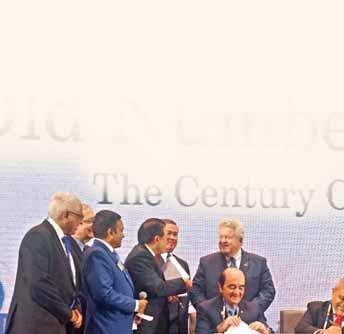
RC Calcutta has taken up diverse projects worth $3 million (`20 crore) to mark its centennial with RIPN Shekhar
RC Manila President Jackie Rodriguez (seated L) and RC Calcutta President Purnendhu Roy Chowdhury (R) sign an MoA in the presence of RC Calcutta past president Saumen Ray; DG Ajay Agarwal; Nick Locsin, Chairman, International Relations Committee, Manila; RI President Mark Maloney; RIPN Shekhar Mehta and PDG Rajani Mukerji.
Mehta giving it all encouragement and support. “So far, we have built 1,000 toilets, 200 borewells and made 20 villages open defection free. We have constructed a free residential school in Purulia for 250 children, while two such schools for 200 students each in Howrah and Barmangwa are in the making,” said the club’s Centennial Committee Chair Saumen Ray. Besides 1,000 heart surgeries, 100,000 children were immunised in Howrah.
Twenty-nine Rotary clubs were sponsored including RC Calcutta Centenary to mark 100 years of Rotary in India and “we are on course to achieve the target of inducting 100 Rotarians, 100 Rotaractors and 300 Interactors in our district,” said Ray. RC Calcutta is targeting to add 38 new members this Rotary year. The vintage club has added 10 new global partner clubs and opened Rotary wards in two government hospitals to serve thousands of patients. Fundraisers like the Centennial Golf Tournament and Vintage Car Show created a new Rotary buzz in the city.
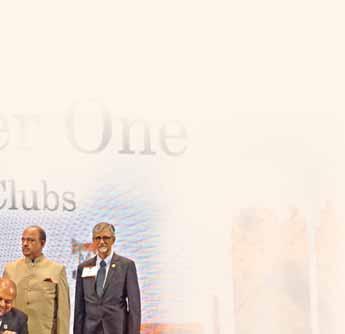
Following the lead given by RID Bharat Pandya, “we are thinking of doing a $2 million scale grant project in which 100 villages will be turned into ODF and 100 schools will become Happy Schools with the help of five domestic clubs and five foreign clubs. This grand project is being worked out,” said Ray.
Till now, the centennial projects had reached out to 1.2 lakh beneficiaries in and around Kolkata. “With the MoA for the Circle of Centennial Clubs, we are extending our fellowship and networking with such clubs across the world for a snowballing effect,” he added. PDG Rajani Mukerji gave the vote of thanks.

Picture by Jaishree

Ni hao, Rotarians!
ake this Confucius quote: “The failure to cultivate virtue, the failure to examine and analyse what I have learned, the inability to move toward righteousness after being shown the way, the inability to correct my faults — these are the causes of my grief.”
If you turn the saying around to positive language, it sounds exactly like the first goal of the new Rotary Action Plan. When we talk about Rotary increasing our impact, we mean investing in relationships, making decisions grounded in evidence, mobilising our resources to create solutions that last, and always learning from our experiences.
The Rotary Foundation already does this so well and will continue to be the best possible investment in a better world as the Action Plan is put into effect. Our global grants respond to real community needs.
Now your Foundation is making a difference on a broader scale than ever through our programs of scale grants. These are competitive grants, designed to respond to a need that a community has identified. Programs of scale will benefit a large number of people in a significant geographic area. They will be sustainable, evidence-based interventions with measurable outcomes and impact. Each grant will support, for three to five years, activities that align with one or more of Rotary’s areas of focus.
Programs of scale build on our experience in the eradication of polio, and we must never forget that we still have important work to do to eliminate this disease. When I visited Pakistan in November, I was overjoyed to see so many young Rotary leaders working hard for End Polio Now.
Wonderful things are happening with our global grants, and the Rotary Action Plan will help us do more than ever. Let us continue to cultivate virtue, examine and analyse what we learn, move toward righteousness based on our new knowledge, and keep improving everything we do.
Hank Sartin

In years past, the pineapple was practically synonymous with Hawaii: At one time, the islands supplied more than 80 per cent of the world’s canned pineapple. Although the last pineapple cannery in the State closed in 2007 and the islands’ vast pineapple plantations have mostly given way to more varied agriculture, when you are in Honolulu for the Rotary International Convention, June 6–10, you can still enjoy a taste of this tropical treat.
The Dole Plantation offers tours including the Pineapple Express Train Tour, which explores the history and botany of the fruit. Did you know that a pineapple starts out as a cluster of berries that grow together? The tour also delves into the story of James Dole, who drove the development of the pineapple industry in Hawaii.
On the Plantation Garden Tour, you’ll see how coffee, cacao, and some of the flowers commonly used to make leis — plumeria, pikake, and pua kenikeni, among others — are grown. If you’ve brought the family to the convention, kids will enjoy the Pineapple Garden Maze, with 2½ miles of paths spread over three acres. After you find your way out, stop at the Plantation Grille for a Dole Whip, a pineapple-flavoured soft-serve treat.
Gary C K Huang Foundation Trustee Chair

Don’t miss the 2020 Rotary Convention in Honolulu. Register at riconvention.org by Mar 31 to save.
©The Rotarian







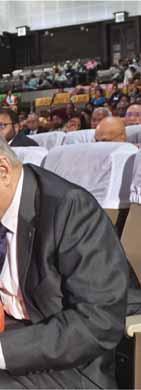
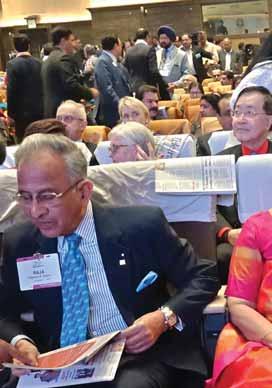





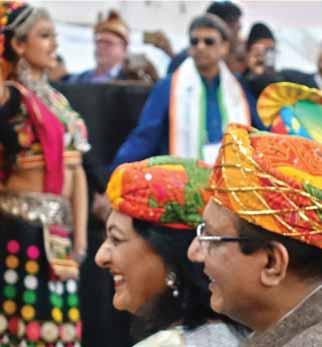


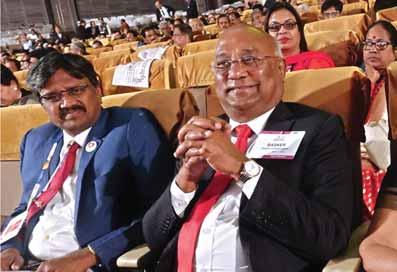
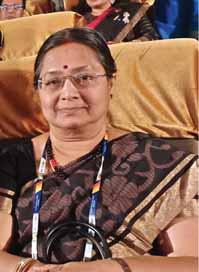
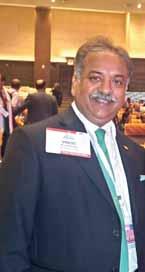
RI



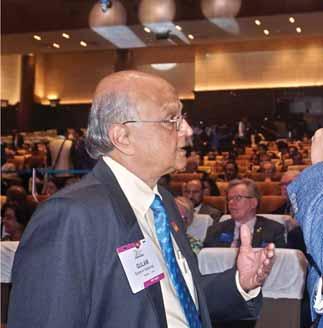
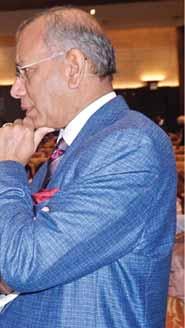

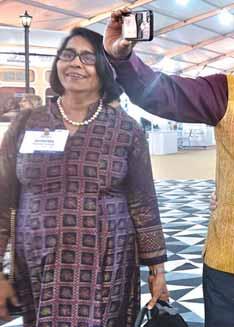
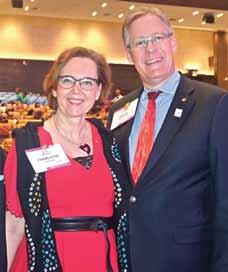


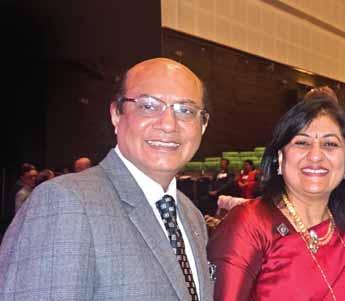
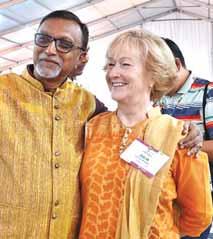





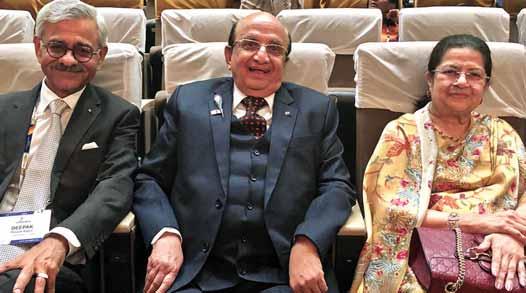

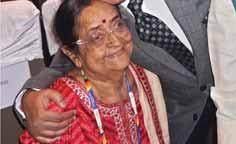
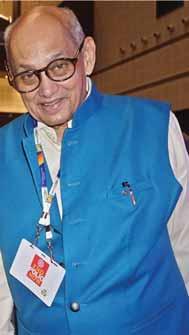

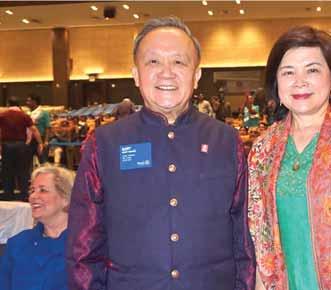
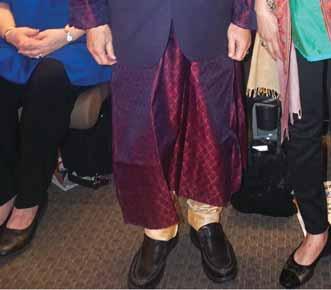

(from




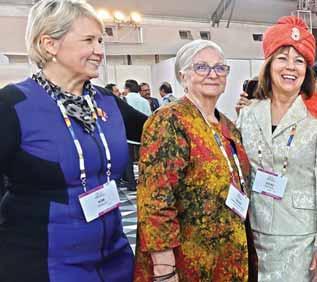



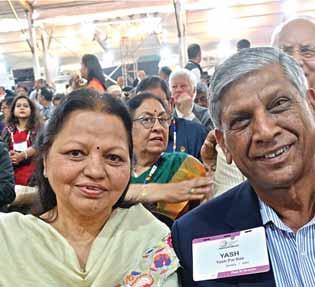
Below: PRID Panduranga Setty and PDG Nayan Patel.
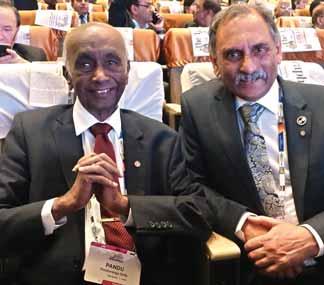
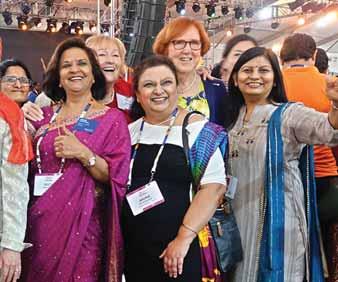






A youthful outlook isn’t the only key to rejuvenating Rotary, but it’s a start. For President-elect Holger Knaack, the opportunities are endless.
Outside of One Rotary Center, it was an overcast October day. Lake Michigan shimmered a steely grey, and the trees’ red and orange leaves appeared drab.
But inside the office of Rotary’s President-elect, it was a bright new day, and not just because of the paisley handkerchief sprouting from the breast pocket of Holger Knaack’s blue blazer. Those vivid colours matched the cheerful attitude with which Knaack looks optimistically to the future — only one of the 67-year-old’s youthful traits.
Over two hours, on two separate occasions, Knaack sat down for a conversation with John Rezek, Editor-inchief of The Rotarian , and Jenny Llakmani, the magazine’s Managing Editor. Speaking fluent, German-inflected English, Knaack discussed his atypical rise in Rotary, an ascent propelled by his longtime involvement with the Rotary Youth Exchange programme. Those experiences define his aspirations as president. “Growing Rotary, and especially growing with young members, will definitely be one of my goals,” he said. “Because if we lose contact with the younger generation” — he lifted his hands and shrugged — “we are outdated.”
During the conversation, Knaack discussed his January 2018 speech at the International Assembly, where he had quoted Paul Harris: “If Rotary is to realise
The Rotarian: You’re the first president-elect from Germany in Rotary’s history. Tell us about the nature of Rotary in Germany.
Knaack: Rotary is different all over the world. We all share the same core values, but with different emphasis. In Germany, it’s really about friendship or fellowship — and it’s about integrity and ethics. That’s how German Rotarians look for members. And then the service we do grows out of friendship. I think one of the major points
its proper destiny, it must be evolutionary at times, revolutionary on occasions.” He then offered his own take on that thought: “To be prepared for the future, Rotary must continue to be revolutionary and must believe in the power of youth.”
Knaack introduced a few aphorisms of his own — including “There’s no wrong age to become a Rotarian” — and spoke about the economic necessity of having a presidential tie (Knaack, who rarely wears a tie, revealed that he keeps one of Mark Daniel Maloney’s blue presidential ties tucked into a desk drawer to have on hand if needed). He also introduced his presidential theme: Rotary Opens Opportunities . The phrase is paired visually with the silhouette of three open doors, one blue, another gold, and the third in bright Rotaract pink. He chose the theme for its aptness, explains Knaack, and because “it’s easy to translate in every language.” (In Knaack’s native German, it’s Rotary eröffnet Möglichkeiten ).
During the first interview, Knaack’s wife, Susanne, sat in and provided clarifications. When Rezek asked Knaack about his reputation for being “unflappable,” the President-elect responded with a flapped expression. After briefly consulting her phone, Susanne provided a translation: unerschütterlich . With that settled, Knaack, ever imperturbable, continued the conversation.
is that German Rotary clubs select their members carefully, and we have a very good retention rate. We don’t even think about retention.
TR: How did you get involved in Rotary?
Knaack: For me, it started with an organisation called Round Table, which has hundreds of clubs in Europe. Surprisingly, it was founded by Rotarians in England in 1927 who were tired of always hanging
out with old men. So they created a new organisation, Round Table, but stipulated that you had to leave when you turned 40. I joined at 30 and left when I was 39. They had this wonderful motto: Adopt, Adapt, Improve. I was interested in service; I was also interested in networking. Many of my friends from this organisation joined Rotary, and again, the reason was the opportunity for networking, especially because of Rotary’s classification system. You need different people to make an organisation more interesting,
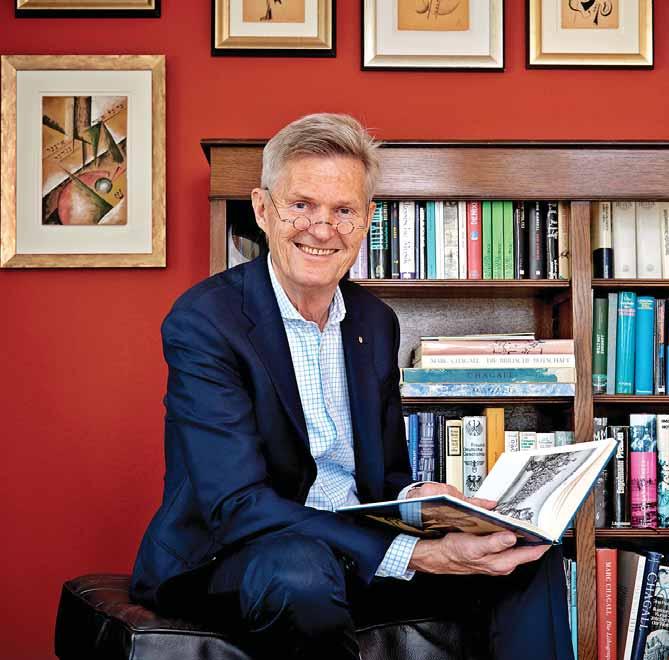
to have discussions go in unexpected directions.
I was asked to join the Rotary Club of Herzogtum LauenburgMölln. It’s a crazy name. When Ron Burton was a director, he once introduced me as “Holger Knaack from the Rotary Club of (pauses) somewhere in Germany.” A new Rotary club in my hometown, Ratzeburg, was looking for members, but I knew many of the people in that club
already, so I decided to join the old club. It gave me the opportunity to meet totally different people.
TR: What was your pathway to the presidency of Rotary?
Knaack: I’ve been asked to list all the district leadership positions I held before I became a district governor. None. Zero. I didn’t have any before I became district governor,
and I didn’t have any appointments in the district leadership. I was just known for my engagement in Youth Exchange, and because of that, people knew about me and my passion for Rotary. It was the same thing when I became a director: I had never, ever had any appointments at the zone level. When I came here to Evanston for my director-elect training, that was the first time I entered this building.
TR: What is it about Youth Exchange that makes it such a great programme?
Knaack: Youth Exchange was my path into Rotary. Susanne and I hosted Rotary Youth Exchange students and became involved in organising Youth Exchange camps, where Rotary clubs and districts host students from all over the world. And then I learned how this enriched our lives. We don’t have children ourselves, so this programme is really great for us. I think it keeps us young.
TR: We’ve heard that you are unflappable. Nothing upsets you. How can that possibly be true?
Knaack: I can sometimes be embarrassed because of small things, as my wife knows. But when confronted by serious things, when we have to make serious decisions, then I become more calm. Plus, I’m always counting on other people. I know I can’t do anything alone. I have the greatest respect for people who are doing the work — not just doing the work, but doing it with passion. We have to show our respect for all people like that. That’s what I learned very early.
TR: What areas are you going to concentrate on during your year? And what do you hope to accomplish?
Knaack: I have no crazy new ideas. We promised to eradicate polio, and I mean to do everything we can to keep that promise. If we succeed, it will help enhance how Rotary is seen in the world. No 2, of course, is growing Rotary, and that’s not just about growing our membership. It’s about growing Rotary at all levels. It’s about making our organisation stronger. It’s about retention and growing through new Rotary club models. Rotary is indeed one of the slowest-changing


organisations in the world. What we do takes so much time. We have to be much faster.
TR: What about Rotary that don’t have to change?
Knaack: Our core values have always been the basis for what we do. Friendship, diversity, integrity, leadership, service — they will never be outdated. The way we express and live those values, that will change. Our tradition of meeting for a meal might have worked for 100 years. But it doesn’t work anymore, because lunch is no longer a central thing in your life. We have to look for models that young people are interested in. Let them decide what kind of Rotary club they would like to join to share our core values. Rotary is a place for everybody: for young and old, for old club models and for new club models. There’s no need for very strict rules. Let’s enjoy what fits best.
TR: Are you worried that the average age for Rotarians keeps going up?
Knaack: I’m so happy that our older Rotarians remain Rotarians and that older people still join Rotary clubs. They’re a great value for the clubs and our organisation. But I want to encourage Rotary clubs to think about their future. Clubs should have a strategic meeting twice a year. If they really think about their future, it’s important that there is no big gap between age groups. If they’re able to attract members in every age group, in every decade, then there is not a big gap. It’s important for Rotary clubs to stay on track and yet still be interesting for young professionals. It’s always dangerous if a Rotary club says, “OK, we have the perfect number of members. We have 50 or 60 or 70 or whatever; we don’t want any more members right now.” Then the gap
can grow very, very fast. One of my sayings is, “There’s no wrong age to become a Rotarian.” If someone is 18 and becoming a member, that’s great. And if someone is 80, that’s great too. So there is no wrong age to become a Rotarian — and there’s no perfect size for a Rotary club.
TR: We notice that you don’t often wear a tie. Are you going to have an official tie?
Knaack: I learned that we bring in $1.3 million or $1.4 million a year from presidential ties and scarves. That’s a good reason to have one. I like ties. I have a large collection of ties.
TR: In very good condition, we bet. All right, there will be a presidential tie. What’s your theme?
Knaack: Rotary Opens Opportunities
It supports our efforts to grow Rotary, because becoming a Rotarian offers prospective members totally new opportunities.
One of the opportunities is, of course, the opportunity to serve. And then the other part comes into play: We offer opportunities to people who are waiting for our service — providing clean water, opportunities to go to school, and so forth. What we do works in both directions.
TR: People describe you as having a very young attitude. How do you think that will influence your leadership style when you’re president?
Knaack: I hope my leadership style will not change. Some people have said I don’t look presidential enough. But that’s OK. It’s about leadership, not about looking too serious. Besides, we really have to focus on young leaders to stay relevant in this world. We welcome our retirees because they
have the skills, the time, and the passion to contribute. My focus is on innovative clubs, new club models, new club ideas, and young members. I think I can be the right person at the right time to attract more young members.
TR: How do you create the opportunities to bring younger people into leadership positions in Rotary?
Knaack: First of all, we have to rely on them and trust them. They are able to do many things — nearly everything. We should give them the opportunity to lead. Before I started the planning of the Rotary Institute in Berlin in 2014, I had a meeting with Rotaractors. I wanted to hear their ideas about doing something different, and they came up with great ideas. They organised all the breakout sessions, and they did a great job. So just trust them, rely on them.
TR: Is there a way to speed up the advancement of women into leadership positions?
Knaack: In a voluntary organisation, we can’t really push. It doesn’t work. We are a grassroots organisation; it all starts in our Rotary clubs. They should look to have the right people on the committees who nominate district governors. Have the right people there, and we will have more women as governors. Everything is possible: There will be six women on the 2020–21 Board of Directors that I will have the honour to chair.
TR: Do you imagine that it will have a different feel?
Knaack: There shouldn’t be any difference. We are all Rotarians regardless of gender. It’s about passion and leadership. We want the best people; it’s not about counting how many

women. But I love that this is happening right now. The beauty of Rotary is indeed its diversity.
TR: How can we tell others about Rotary and improve our image in the world?
Knaack: It takes a long time, or a lot of money, to change your image in this world. Two things are important: You have to know it takes time, and then you have to be honest. It’s not because of marketing reasons that we have to change. We have to tell a true story of why we are doing things. To really be
a part of Rotary, you have to be proud of the organisation, and we have to be proud of our work. Not about what you are doing. That’s selfish.
TR: Does Rotary need to be cooler?
Knaack: To be attractive for younger members, definitely. I’m proud of our existing Rotary clubs. But if they’re not attractive to Rotaractors or young professionals, we should encourage them to create a club model that works for them. And that’s what we’re going to do in the next few years.
© The Rotarian
Kiran Zehra
RC Rajkot, RID 3060, has set up a skin bank in Rajkot at a cost of `50 lakh with support from RC Cary Kildare, RID 7710, USA, and TRF. An individual donor Sarla Kamdar from Nairobi, Kenya, has also pitched in with her contributions for the cause.
Outlining details of this facility, Club President Sandesh Gandhi says that an extensive research on burn victims revealed that the hospital received nearly 60 burn patients every quarter and 80 per cent of the patients were in the age group 18–40 with second and third-degree burns. Since most of the patients belonged to middle and lower middle-income groups, it was quite impossible for them to buy artificial skin or look for a donor in a short span of time. “We decided to set up the skin bank at the Civil Hospital, as most of the private hospitals in and around Rajkot were not equipped to treat burn patients and they were referred to this hospital,” says Gandhi.
The club applied for a global grant in 2019 and PDG Pinky Patel and past president Hita Mehta helped in establishing the facility.
“Skin burns leave open wounds. With the body’s first line of defence destroyed it undergoes dehydration and temperature loss. In case of severe burns, multi-organ function is affected within three to five days,” says Dr Devvrat Sukhval, a club member and the Rotarian-in-charge of the skin bank. He adds that the skin bank
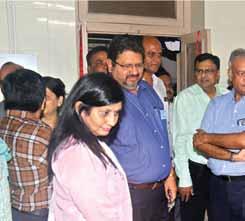

is a boon for patients as there is no need for blood groups to match for the grafting and anyone over 18 years who does not have any skin disease or infections can donate skin.” He explains that in case of extensive burns the electrolyte is imbalanced and impacts the internal organs. “Patients do not survive easily. With skin grafting, once the protective layer of the skin is back, the wound starts healing and it improves the survival rate of the victim.”
The team of doctors and staff at the skin bank have undergone training and can now harvest skin from a cadaver within six hours from the time of death, after consent for the donation is given. An extremely thin layer of skin, 0.4 to 0.6 mm in thickness,


which consists of the epidermis and a part of the dermis, is harvested and stored at a temperature below 4 degree Celsius at the bank.
But there is more work to be done, says the Club President. “People are ready to donate eyes and other organs. But they are not convinced to donate skin as they feel it will disfigure the body.” The club will have to carry out awareness programmes to bust the myth. Dr Sukhval says that the outer layer of the skin from the thighs and legs (1,000 to 1,500 sq cm) is only used, and not the skin from the face or neck or the other visible parts of the limbs. “The demand for skin is increasing but the supply is not adequate owing to such misconceptions and lack of awareness,” he says.
The increase in Polio cases in 2019, mainly in Pakistan, has caused serious concern to Rotary and its partners. In this background, a high-level team of Rotarians comprising RI President Elect Holger Knaack, TRF Chair Elect K R Ravindran and IPPC Chair Michael McGovern visited Pakistan in the first week of February. They were accompanied by incoming Trustee and IPPC Member PDG Aziz Memon of Pakistan, who made all the logistical arrangements.
In a high level review meetings with Pakistan Prime Minister Imran Khan and separately with Army Chief of Staff General Qamar Bajwa, Rotary was assured of the unstinted support and cooperation of both the Army and the civil forces to ensure they reach every child in every nook and corner of Pakistan with the requisite vaccine, Trustee Chair-Elect Ravindran told Rotary News.
“The Prime Minister acknowledged that Pakistan had missed a step last year when he had just won the



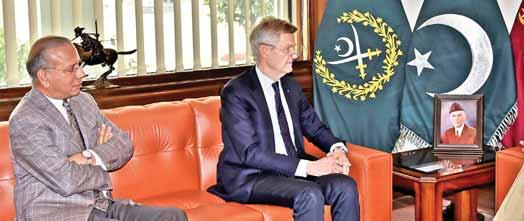
election and a transition government was in power. But he assured us that his Government considered it its primary function to eliminate Polio and had already taken a series of highly effective organisational steps to manage the vaccination programme.”
He added that the Army Chief had also assured them that “he would do everything necessary to ensure that his forces reach the most inaccessible areas and also take every step to shut down the porous border with Afghanistan.”
Both the Prime Minister and the Army Chief confirmed that already much headway had been made in their efforts to build a fence covering the 1,300-mile border with Afghanistan. “They were extremely appreciative of the efforts of Rotary International and
understood the significance of both the President Elect and the Trustee Chair Elect calling on them together to highlight their concern at this critical stage of the polio eradication programme,” Ravindran added.
He said it was clear to the team that Pakistan was making huge efforts in resources and organisation to ensure the setback of last year was not repeated. Health Minister Zafar Mirza confirmed that in the last round just completed approximately 40 million children were vaccinated and the number of missed children was under one per cent.
The Rotary team also visited and inspected the National Emergency Operations Centre where a hi-tech data collection system is in operation to monitor progress in real time, and cold rooms to store the vaccines.
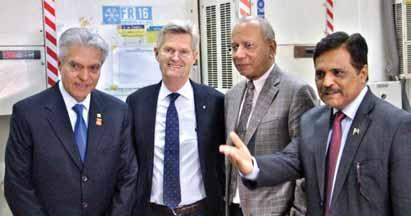
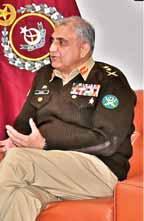
An RI press release said that at the end of the visit RI President Elect Knaack expressed his satisfaction with the efforts taken by the Pakistan Government to eliminate polio. He said, “We are grateful for the opportunity to meet with key leaders in Pakistan to learn about renewed efforts to eradicate the disease once and for all. We’re confident that with the support of the government and the Army, Pakistan will get the job done.”
Added Ravindran: “Polio eradication is a massive effort that will require all elements of society to band together and work towards our ultimate goal of ensuring no child is ever again paralysed by polio.”
During their visit, the Rotary delegation met with local Rotary leaders from Pakistan, which is home to over 230 Rotary clubs and nearly 3,400 members.
Ravindran was optimistic that there would be “a tangible drop in the number of cases this year”, and added that he intends to call the next International PolioPlus Committee (IPPC) meeting in Pakistan, where all the partners including WHO, UNICEF, Gates Foundation and CDC will also be present. “With the wild poliovirus circulating only in Pakistan and Afghanistan, we need to focus all our energies in that area”. This was the first time the IPPC would have its meeting in Pakistan.
Designed by N Krishnamurthy
Kiran Zehra

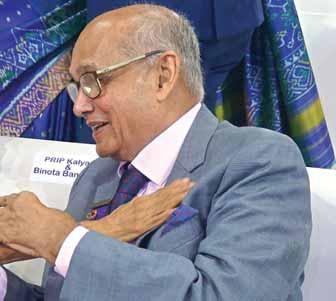

In colourful beach outfits, summer hats and floral garlands, the Rotarians of RID 3060 danced away, as they celebrated their 50 th District Conference at a beach party in Goa. Before he addressed the Rotarians, RIPN Shekar Mehta said DG Anish Shah had achieved a “unique feat,” by having invited and ensured that all the top RI leaders in India make it to his District Conference.
“This speaks volumes about the way he connects with us.”
The two-day conference titled GoldCon, hosted by RC Valsad, the DG’s home club, had over 1,500 delegates including GSE teams from Brazil, Mexico, and Vietnam and 12 RYE students from overseas. While PDG T N Subramanian was the RIPR, other participants included PRIP Kalyan Banerjee, RI Directors
Kamal Sanghvi and Bharat Pandya, RIDN A S Venkatesh, Trustee Gulam Vahanvaty and PRID Manoj Desai.
Recalling his 3 am phone call with DG Anish Shah a day before the conference RIPN Mehta said, “I asked Anish why he hadn’t slept. He said ‘Sir, aap hi se sikha hai, conference ke bad solenge! (we have learnt from you to finish work first, sleep comes later)’. I would like to tell Anish, galat

cheesein mat sekho humse (don’t learn bad habits from us),” he laughed.
Mehta thanked Banerjee, “my mentor with a large vision and great simplicity,” and complimented him for nurturing his district “in a fantastic manner. One visit to his club, RC Vapi, has changed my life.” Calling RID 3060 as one of the most outstanding districts in India, he pointed out seven Rotaractors from this district had becomes DGs.
He urged the delegates to understand the true spirit of ‘Service above Self’. “There is no organisation

Below: DG Anish Shah and RID Bharat Pandya.
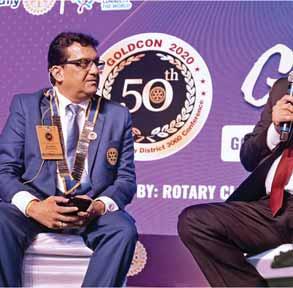



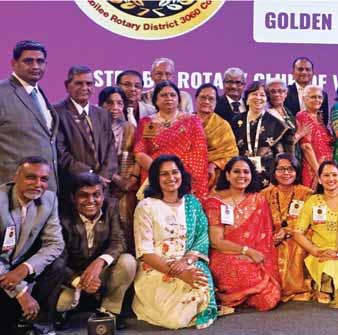
or business in the world which does not know the number of sales it has done or its assets. Why don’t we as Rotarians know the number of schools, blood banks, houses built, students trained. Imagine the pride each one of you will feel when we highlight those numbers. We are definitely a more than $400 million organisation.”
After recounting a little history of the district, Banerjee said: “Coming

to our own conference is always such a pride, So DGE Prashant Jani and DGND Shrikant Indani, let me assure you, regardless of where you host the conference in your year, whether you go to Bangkok or to Colombo or Kathmandu, Binota and I, if we are still around, we will be there.” Congratulating the DG on his achievements, he added, “he has picked the best candidates to do everything and executed each task meticulously.


Above: PDGs and their spouses with senior Rotary leaders.
Below:
(From L) Conference Chair Dharmin Desai, DG Anish Shah and Swati, RID Kamal Sanghvi and Sonal, PRIP Kalyan Banerjee, Vidya and RIPR T N Subramanian.
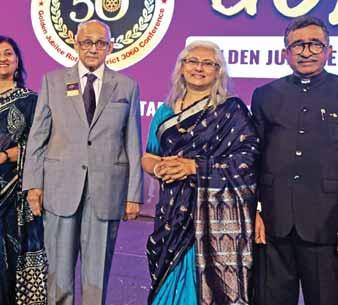


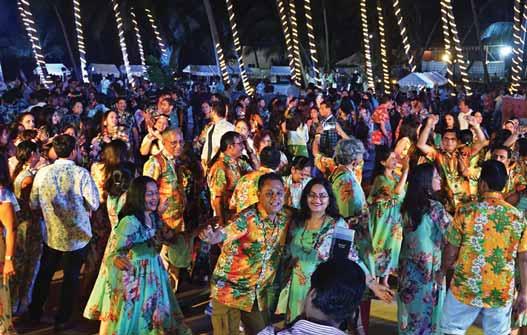
He has every serving Indian Rotary leader here today. I am thoroughly impressed!”
Conveying RI President Mark Maloney’s message, PDG Subramanian said that “there is a responsibility on you Rotarians to fulfil your obligation towards the Rotary Foundation.” In 2015–16, “each and every club in your district had contributed to the Foundation. Anish, you have to make sure this happens again.” Echoing his words TRF Trustee Vahanvaty said, “while we are doing reasonably well in the Polio Fund we are lagging behind in our contribution to the Annual Fund and Endowment. We are far behind; we must contribute to the TRF. The world fund is low and this will impact global grants.” On the district’s 50th year, the Rotarians should set up a target of $2 million contribution to TRF, he added.
Pandya said that strengthening of clubs, humanitarian projects and enhancing public image of Rotary are priority areas. He appreciated the district clubs for taking up a number of community projects and advocating Project Positive Health and asked them
to “continue the good work of making the world a better place.”
Sanghvi reminded Rotarians of the district “not to forget the people who have travelled with you in your journey of excellence. It is very important you respect the people who have guided you and remember your PDGs are your guiding light.” He talked about how important it is to “show gratitude” towards their spouses.
RIDN A S Venkatesh disclosed he had “invited” himself to the conference. “Shah said he had no slot for me. But I know how to make a Gujju say yes. I told him I could address the gathering on Business of Rotary, and he agreed instantly.” On a serious note, he asked the club presidents to “treat your club members as customers and make sure they are happy. Over the last seven years, we have lost many customers (members) and we don’t know the right way to attract new ones or keep back old ones. We have to work on this.”
PRID Manoj Desai said “many Rotarians ask me ‘What do I do to become the RI President?’” Pointing at a picture of RIPN Mehta on a boat with shelter kits on the large LCD screen,
he said: “Conduct a few thousand paediatric heart surgeries, meet the children, greet the parents, pick them up and drop them to the airport, go to flood-affected areas, distribute shelter kits yourself and then maybe you can become one of the youngest RI President like Shekhar.” Working hard is the only key to climb up the ladder and “you have to do that selflessly,” he reminded the Rotarians in the hall.
DG Shah gave an overview of the of projects, membership, new clubs, Rotaract engagement and collection of funds. He thanked all the PDGs and club presidents who had helped him implement the strategic plan in the entire district. “You have helped me enhance Rotary’s public image and touch more lives, put me on a pedestal. Without your support, I would have never achieved all this.”
PDG Pinky Patel presented the accounts for 2018–19 followed by the district awards.The highlight of the conference were spectacular cultural performances from the GSE and RYE teams and Goan dance performances.
Pictures by Kiran Zehra
V Muthukumaran
As Rotary is poised for an exponential growth in India, “we should take a pledge to induct at least one new member each in the next 18 months for we have a responsibility to determine what Rotary is going to be in the next 10 years and that depends on what we do today,” said RIDN A S Venkatesh.
While we can take pride in Rotary’s legacy, all of us have to be ‘proactive’ to take this NGO to its deserving status by 2030. “In the last two years, less than 10 per cent of our members would have

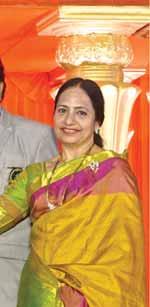
From L: Mala and PRID C Basker, DG (3232) G Chandramohan, Shakila and DG Pasha, RIPR PDG Janice Kurth from D 5340 with her husband Rtn Matt.
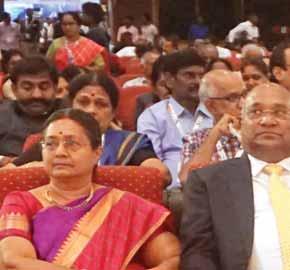
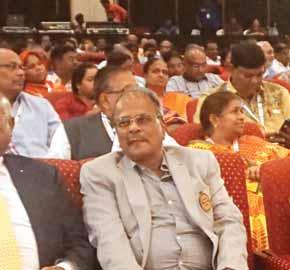

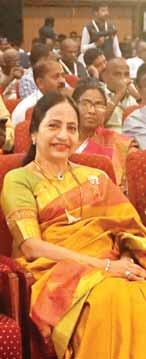
recommended or inducted a new member to their clubs,” he noted and urged Rotarians of RID 3000 to always wear their Rotary pins. He shared his dreams for Rotary at the two-day district conference of RID 3000 titled Simmasanam (throne) in Chennai.
“It will give a chance for us to explain about our organisation whenever the public question us about the pin.” If all the 150,000 Rotarians in India wear their pins whenever they go, “they become our brand ambassadors.”
Secondly, people should come forward to join Rotary, instead of being pushed, and this can be done if “only our conduct, behaviour, actions and community initiatives make Rotary an attractive proposition for them,” he said. Rotary should draw new members spontaneously and for which, a lot depends on “what Rotarians do now.” His third dream is to make Rotary the organisation of choice for people to donate liberally for noble causes. As non-Rotarians will judge the NGO based on how Rotarians acquit themselves in various community projects, it is
important for members to shore up their public image in the years to come, Venkatesh noted.
PRID C Basker said RID 3000 has come a long way since it was bifurcated from Sri Lanka as a separate district in 1993. “At that time we had just 28 clubs, were the smallest district in India and the third lowest in TRF giving in the world. Today, we are number one in membership growth and have reached several milestones for which the credit must go to the PDGs of this district over the last 28 years,” he said.
Talking about ‘Self empowerment in Rotary’, he said that perceptions of value differ according to individuals. “If you ask PDG Janice Kurth, the RIPR, she may value friendship and fellowship in Rotary more than anything else, for Indian Rotarians it will be community service which may not be the case for members in Europe and Australia,” he explained. The perceptions among Rotarians vary across the geographical zones, whereas Rotary is the same everywhere.
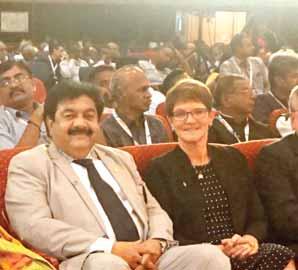

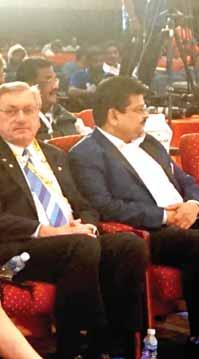
During his tenure as district governor 20 years ago, Rotary clubs in India were looking up to foreign donors to carry out service projects. “We are no more a poor country. The top two districts in TRF giving were in India in 2018–19 and in membership growth, the top three districts were from our zones.” He had asserted at the RI Board that Asia was a growing power and “India would become a developed nation soon.”
An average Indian has a per capita income of `1.2 lakh and now, Rotary clubs in India are taking up the largest number of community projects without any funding problems, he said. “Clubs in RID 3000 should understand the needs and requirements of their communities and take up projects wherever necessary. A club should have a minimum of 25 members and all of them should join hands in implementing service projects,” Basker added.
DG Dr Zameer Pasha felicitated Venkatesh and Basker with mementoes. The discon was inaugurated by Tamil Nadu Governor Banwarilal Purohit and the valedictory address was given by Telangana Governor Dr Tamilisai Soundararajan. Over 2,200 delegates from 126 clubs of RID 3000 attended the conclave with their families. Major Donor G Sundararajan from Dindigul; R Srinivasan, a retired staff of TVS Company from Madurai; and V V Subramanian, Director, Hindu Mission Hospital, Trichy, were honoured with Vocational Excellence Awards.
Pictures by V Muthukumaran
Afew months ago when A N Aiyanna, Presidentelect of RC Mysore Midtown, RID 3181, was returning from Rotary Midtown Academy, a high school run by his club, he spotted a teenage boy, who seemed to be a bundle of energy despite some deformity that was preventing him from walking normally. “I was riding pillion on the two-wheeler of my Rotarian friend Satish Babu; I asked him to stop the bike and went to the boy, who was waiting alone on the footpath to take the public bus back home.”
He found that Lohith was a Class 10 student of the Hemavathi School, Mysuru, and had been born with one leg shorter than the other. This prevented him from walking normally.
“Being a Rotarian, looking at his disability and difficulty in walking normally, I sat with him for some time discussing about his family and his education,” says Aiyanna. He also found that Lohith was sweating profusely as he had been playing kabaddi with his friends at school. “I marvelled at his I marvelled at his strength, because he had not allowed his disability to dampen his spirit.
RC Mysore Midtown President-elect
A N Aiyanna (second from L) with Lohith and Interactors of Rotary Midtown Academy.
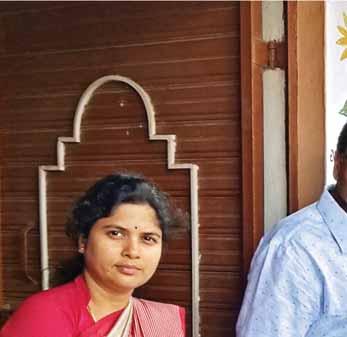


strength, because he had not allowed his disability to dampen his spirit.”
With Lohith’s father being a pushcart vegetable vendor, the family could not afford any form of artificial support which would enable him to walk normally. “Amazed to find that he loved physical exercise and games, I wanted to help him, and gave my contact details to him and asked him to get his father to call me,” he says.
But when he didn’t get a call after several days, Aiyanna visited the boy’s school to get some details. “Poor response from the school staff that day made me return with a heavy heart.” But he didn’t give up; he discussed Lohith’s case with a Rotarian friend who works in the healthcare industry — the JSS Hospital in Mysuru that designs and fabricates prosthetic limbs.
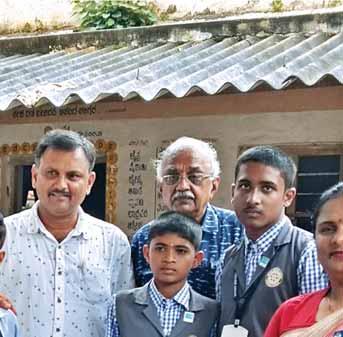
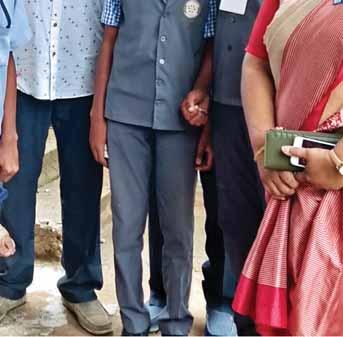

Our Interactors raised the amount required — about `8,000, and Lohith
prosthetic limb.
Aiyanna made another visit to Lohith’s school and this time managed to meet and speak to the headmaster, got more details, took a photograph of the boy’s deformed foot and shared it with some doctors. With the boy’s uncle Nagendra getting involved, the boy was taken to the hospital and initially the doctors said a surgery would be needed before the prosthetic limb could be fitted. But with both Lohith’s family and Aiyanna himself, being hesitant about surgery, the idea was shelved.
But this teenager’s story and zest for games such as kabaddi generated quite a lot of interest and with Aiyanna not giving up his pursuit of finding a solution, “our school headmistress, Ramya Urs, also got involved, and agreed to sponsor the specially-designed artificial limb through Interactors.”
By this time, the Rotarian working at the JSS Hospital said a customised prosthetic leg could be fitted on Lohith without any surgical intervention. Hearteningly enough, the Interact club sponsored by RC Mysore Midtown raised the amount required — about `8,000, a concessional rate given by the JSS Hospital, and Lohith finally got a suitable prosthetic limb.
Aiyanna is happy that Lohith “no longer has to limp and can walk normally and play his favourite games. This experience has taught me that if we are sincere, dedicated and committed to doing something, we can do it!”
Soon Chennai will see pinkcoloured autorickshaws driven by women, thanks to the Rotarians of Rotary District 3232. “It became my dream project after I saw a similar programme during my visit to Japan last year. I want to see women in the driver’s seat in the literal sense. They must become financially independent and only then their entire family will grow with them,” said DG G Chandramohan at an event held recently in Chennai. The district plans to donate ‘pink autos’ to 100 underprivileged women and train 200 women to drive autos.
Rotary clubs of the district have pitched in to support the programme with several Rotarians sponsoring autorickshaws for women. Nina Reddy, Managing Director, Hotel Savera, donated autos to two beneficiaries from her company’s CSR funds; so did PDG Raja
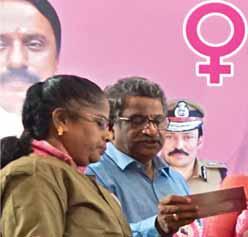
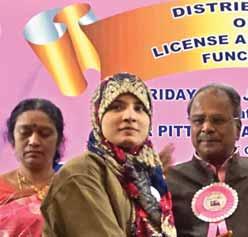
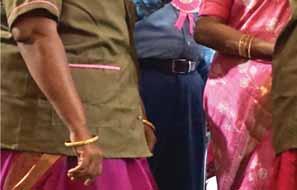
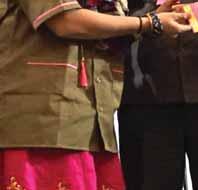
Seenivasan and Manjula, wife of DG Chandramohan. Anees Begum, President of RC Chennai Sunrise, sponsored three autorickshaws, while Ampa Palaniappan of Ampa Sky Walk mall, presented a cheque for `1 lakh, among others.
Project Chair Shanthi Selvam said that when the work for the project began in the first week of July, a team visited five slums in various localities of the city to identify needy women who could benefit from the project.
Women must become financially independent and only then their entire family will grow with them.
“We double-checked their socioeconomic status before selecting them for training and then enrolled them in a driving school for a fortnight.”
These women were given badges, ID cards and licence at this event and the hall was charged with their excitement and confidence.
“It’s a lifelong skill and we hope that more women benefit from this endeavour,” said Shanthi.
Mahalakshmi (42) from the city’s suburb is one such beneficiary. After years of juggling with different kinds of menial jobs for livelihood, she got an auto on rent three years ago. Being the sole breadwinner, it wasn’t easy for her to manage household expenses and pay her daughter’s school fees.
“I was one of the first few women autorickshaw drivers in the city. Women and girls have often told me that they felt safe in my
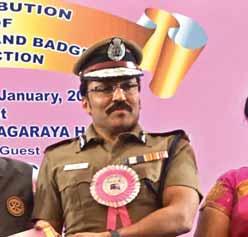
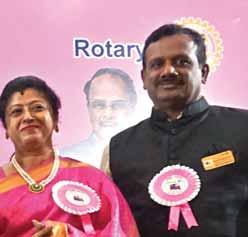

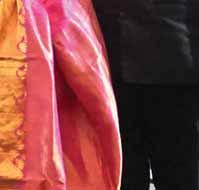
Below: Women auto drivers all excited to receive their licence and badge.
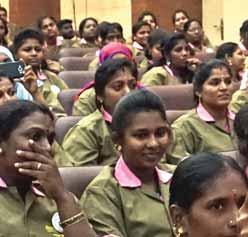
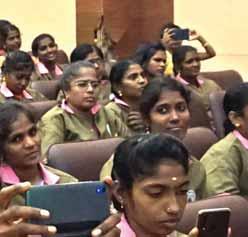


You can frame an award to be given to women auto drivers who follow traffic rules and road discipline.
auto. They clicked pictures and appreciated me for my dedication and confidence. On the flip side, the amount I earned from the rides was spent on monthly rent and petrol. I hardly had any savings for my daughter’s education. A Rotary member who took a ride in my auto heard my story and promised to help. I’m happy that I will ride my own auto without having to pay rent,” smiled Mahalakshmi, sporting the ubiquitous brand-new brown coat, the autodriver’s uniform, which was provided as part of the project.
Shanthi said the women drivers can earn a minimum `1,500 a day, and easily save `1,000, after meeting vital expenses such as fuel.
ADGP M Ravi, the chief guest, commended the Rotarians for the initiative and said that it would contribute to women’s safety on roads. He urged the 200 women to become Mahila Police Volunteers and act as a bridge between police and public to help fight crimes against women. To the Rotarians, he said, “You can frame an award to be given to women auto drivers who follow traffic rules and road discipline. They will set an example for the male counterparts.”
The pink autos are fitted with GPS and electronic metres and sports a Rotary wheel at the rear.
Kiran Zehra
Women members are a vibrant and important part of Rotary,” said RIDN A S Venkatesh, addressing the 300 women delegates from RIDs 3190, 3160, 3150, 3141, 3142 and 3131 at Samhita, a conference for women Rotarians, hosted by RC Gargis, RID 3170, in Kolhapur. “Women have begun assuming leadership positions throughout the Rotary world as club presidents, district governors and officers. Eight out of 17 members at the International Rotary Management Committee are women,” he added, and urged that each Rotarian should add at least one woman to their club.
The conclave focused on promoting ideas for making Rotary attractive for women and brought together field experts and senior district leaders to discuss and deliberate on the topic. Gauri Hiremath, RID 3170’s Coordinator for Women in Rotary said that the respect for women has grown
tremendously. “I don’t see myself as a woman in Rotary, I am a Rotarian and am grateful to my Rotary family to have helped me learn and grow while serving the society.”
DG Girish Masurkar described the struggle of women “right from the time when in 1978, the Rotary Club of Duarte, California, USA, invited three women to become members. This was followed by the club’s charter being revoked and a nine-year court battle that resulted in the historic CoL of 1989, where it was voted to eliminate the “male only” provision for membership in Rotary.” He said that his district had 700 women members, “and I will do my best to increase that number.”
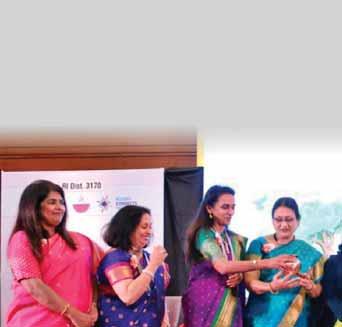
Jhilam Roy Chowdhury, RILM’s Director-Programmes, in her address said, “Women intuitively understand conflict resolution and the importance of working towards an environment-friendly and secular future. Conferences like Samhita
From R: PDG Anand Kulkarni, DG Girish Masurkar (third from R) and RIDN A S Venkatesh at the inaugural of the Women Rotarians conclave.
give an opportunity to highlight our achievements and face challenges bravely.”
Dr Meenakshi Bharat, a gynaecologist and member of RC Bangalore West, RID 3190, sensitised the Rotarians to focus more programmes on addressing the ‘period stigma’. “Together we must make sure that all girls are well-informed about menstruation and how to manage it in a hygienic manner,” she said.
Other sessions included topics on health, leadership and conservation of water.
PDG Shyamshree Sen, RID 3291, urged the women Rotarians to get better involved in service projects and improve the membership strength. “After great efforts women have become part of Rotary, but the numbers are marginal. The acceptance of women in the clubs will make Rotary vibrant for the next 100 years,” she said.



TheLittle Big Hearts Project of RC Meenambakkam, RID 3232, supports surgical correction of congenital heart defects (CHD) in children from underprivileged families. The club, along with TRF, and 11 Rotary clubs from Canada, Australia, Italy and Africa, had planned to perform 100 such surgeries for children. So far, ` 56 lakh has been spent for the treatment which is done at three hospitals in Chennai — Sooriya, The Madras Medical Mission, MIOT Hospitals — and the project is supported by Genesis Foundation, another NGO, said the project’s primary contact B Dakshayani.
The programme was officially launched in Feb last year by PRID C Basker, and has completed 100 surgeries. TRF Trustee Gulam Vahanvaty, along with DG G Chandramohan,
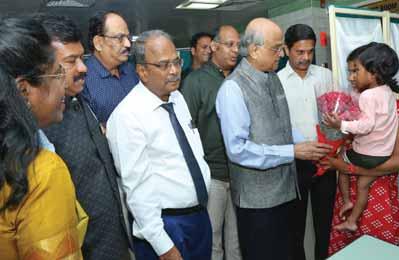
Trustee Gulam
a child and mother in the presence of DG G Chandramohan, PDG C R Raju and Project Coordinator B Dakshayani.
visited MIOT Hospital and met the child who was to be treated and wished her luck for the surgery. He met few other young beneficiaries of the project
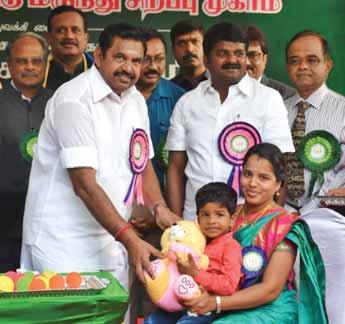
Tamil Nadu Chief Minister Edappadi Palaniswami gifts a toy to a child at the NID camp. Also present DG G Chandramohan, District Secretary Ganapathy Suresh and State Health Minister C Vijayabaskar.
and acknowledged the good work done by the partnering hospitals and the contributing Rotary clubs across the globe and the NGO partner.
RID 3232 organised an NID camp recently with Tamil Nadu Chief Minister Edappadi Palaniswami as the chief guest. The polio camp was held at the CM’s residence.
DG G Chandramohan, District PolioPlus Chair C Muthuswamy and District Secretary Ganapathy Suresh were present along with the government officials from the Greater Chennai Corporation. The Chief Minister administered polio drops to children and appreciated Rotary’s various service projects, highlighting its role in eradication of polio in India and world over. Soft toys were gifted to the children at the NID camp.
It was a major exercise in image building, said Muthuswamy.
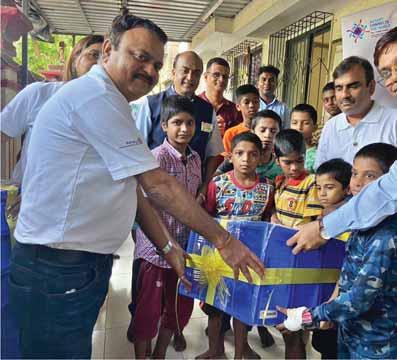

Rotary Club of Hiranandani Estate, RID 3142, has undertaken a unique project of providing ‘Hygiene Kitchen’ for public organisations such as orphanages and old-age homes where the kitchen is in bad shape. “Serving safe food is not an option, it is an obligation. And more so when there are children and the elderly to take care of,” says Club President Dr Namrataa Srivastav. The project aims to
upgrade the infrastructure, perform repairs, provide amenities and enhance the hygiene standards to establish safety and prevent food contamination of any form. It is being done with support from Muenzer Bharat, an organisation that works with the mission, Swachh Bharat, Swasth Bharat.
Two institutions were identified in the first instance. The Desire Society is an orphanage that looks after 50
HIV-positive boys. “We provided a refrigerator, storage containers, serving bowls and cutlery here,” says Namraata. The next kitchen was that of the Vatsalya Trust that takes care of 30 elderly people and 20 orphaned girls. “It was a total revamp here.”
The walls were painted, new shelves and cooking platform put in place, floors tiles were relaid and the electrical wiring was redone. “At the end of it all, we were satisfied at the
whole transformation. The kitchen is the most important part of a house from where healthy food gets to the table and it must be excellent enough to inspire a person to cook,” she quips.
The kitchens were handed over officially to the beneficiaries in an event presided over by DGN Mayuresh Warke, District Secretary Vinit Shah, Project Director Pradeep Thakur and the club members. Michael Muenzer, the CEO of the partner organisation Muenzer Bharat, its Director Gregor Alexander Reindl, MD Sanjay Srivastaava and the Project Head Anjali Singh were also present.
The project will support eight more kitchens before the year-end.
The partnering teams are also working with the food and beverage organisations (FBOs) for safe and proper disposal of used cooking oil, “to prevent it from being sold to street-side vendors for preparing vadapav and samosas. That is actually inviting cancer,” says
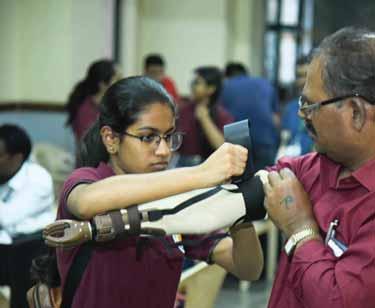

Namraata. Muenzer Bharat offers to buy the used oil from FBOs and processes it into environment-friendly biodiesel.
More recently, the club, in association with RC Poona Downtown, RID 3131, and RC Kalyan, conducted an LN-4 prosthetic hands fitment camp in Thane. Nearly 500 people who had lost their hand due to accident or electric shock were fitted with these artificial hands developed by Ellen Meadows Foundation, USA. They were also trained by technicians to use their new ‘hands’ to write and hold or lift articles.
Extensive publicity in social and print media helped in reaching out to beneficiaries from across the country, says the Project Chairperson Arunima Singh. Rotaractors and Inner Wheel members ensured smooth progress of the camp.
ProjectSparsh is a big success as it offers medical care to bedridden patients at their home in Jagdalpur. The nursing service launched by RC Jagdalpur, RID 3261, in partnership with the Christ College of Nursing involves a car and a team of paramedics attending to patients after receiving calls to a designated mobile number. “Once the call is received, time and place of treatment are noted down by the medical staff who reach the homes at the appointed time to offer a range of services,” said Satyanarain Agrawal, past president, RC Jagdalpur. Usually, time of the visit is between 8 am and 11 am and the procedures

include bedside care, body dressing, BP, sugar check, temperature, sponge bath and medication. “We are receiving calls almost every day. We assess each
case and plan the car visit to the patient’s home well in advance.” While Rotary provided the car ambulance, the nursing college is giving their paramed-
ics for the Sparsh Project. “All the medical care by the nurses and the car visit are totally free and nothing is charged on the patients,” said Agrawal.

hat is the biggest killer in the world? It is not smoking or alcohol, but bad and calorie-heavy food. “Bad, unhealthy food kills more people than terrorism does. And Indians are genetically prone to non-communicable diseases (NCDs) such as obesity, hypertension, stroke and diabetes which are silent killers,” said Dr Umesh Khanna, a leading nephrologist in Mumbai who has done over 250 renal transplants. As Project Coordinator of Jeevan Sparsh, an NGO, he is one of the architects of Project Positive Health : Stop NCDs that aims to control the epidemic arising from unhealthy food and sedentary lifestyles.
Speaking at the Connect with Health session at the Rotary Institute, Indore, Khanna, also the Founderchairman of Mumbai Kidney Foundation, said one in every three Indian adults is obese now and the country will have an estimated 17 million obese children, comprising 90 per cent of their population by 2025. Globally, 41 million people die of NCDs in a year, accounting for 71 per cent of all deaths, according to WHO. In India, NCDs account for 60 per cent of all deaths as the average daily consumption of salt, sugar and oil exceeds more than the WHO prescribed levels. “There is a nothing called sudden cardiac arrest, it takes years for such a fatal attack on the body and you are solely responsible for it,” he said.
An estimated 25 per cent of Indians have high BP and about 20 per cent have higher than acceptable sugar levels. “What is alarming is that most of them, especially in rural areas, don’t know that they suffer from such risk
V Muthukumaran

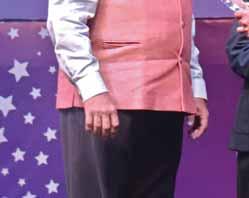
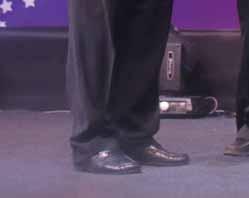
factors leading to NCDs,” he said. India cannot afford this epidemic and hence, Rotary has taken the Stop NCD Project which is aimed to reverse this dangerous trend. “Rotary has the reach, ability and depth of penetration to take up the NCD challenge. While creating awareness, it is also taking up capacity building and in an advocacy role with the government, has called
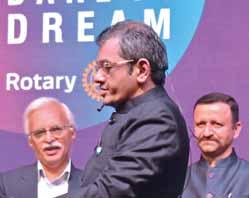
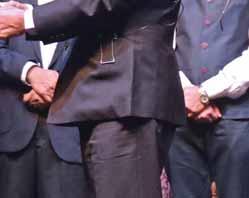

for making food labelling mandatory,” he explained.
In a panel discussion, Dr Hemal Shah, Secretary, Mumbai Nephrology Group, broke some of the prevailing myths such as taking medicine for BP is enough and young people will not suffer from high BP (>140/90). “You have to check BP level regularly as symptoms might not be visible. If left




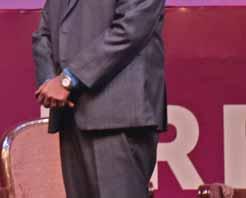
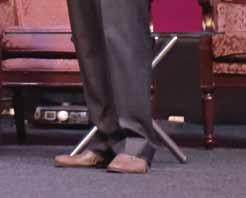
untreated, high BP damages organs, leads to stroke, vision loss and multiple complications.”
Dr Zamurrud M Patel, HoD, Diabetes Department, Global Hospitals, Mumbai, called for a healthy diet rich in vitamins and nutrients. “Instead of
binging on your favourite food, eat moderately at regular intervals of time. Avoid smoking and alcohol, and exercise daily.” All packed or processed foods are harmful as they have preservatives with hidden salts and other ingredients that increase the risk factors for NCDs.
Rotary has the reach, ability and depth of penetration to take up the NCD challenge.
Dr Umesh Khanna
Diabetes is a silent killer, and 50 per cent of diabetics are unaware of their condition until they test positive in medical camps or health check-ups, said Dr Sandeep Julka, Endocrinologist, CHL Hospital, Indore. No time for exercise is an invitation for diseases. “What is alarming is that even children are getting Type-II diabetes, which is on the rise in the last 18 years. If both the parents are diabetics, then their children have a 50 per cent chance of getting this disorder; and if a single parent is diabetic, the children have a 25 per cent chance to have high blood sugar. On an average, diabetics lose six years of their life due to excess blood sugar,” he said.
On obesity, Dr Hemal Shah said that a BMI (body mass index) of over 25 comes under obesity, while 23–25 makes you overweight. “Around 30 lakh people die due to obesity-related disorders in the world and 20 per cent of all cancers are caused by excess fat tissues.”
In his closing remarks, RID Bharat Pandya said all the four panellists have suggested some well-meaning steps for a disease-free life, “unlike businessmen who make profit at the cost of people’s health.” PRID Manoj Desai felicitated the doctors.
Picture by V Muthukumaran
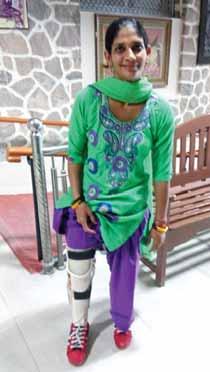
Whilethe eradication of poliomyelitis from India in 2011 was a milestone for Rotary, very few people have given thought to patients still suffering from the debilitating effects of this crippling disease. Numbering around lakhs, mostly elder citizens, they have to put up with conventional calipers made of metal and leather, forcing them to use black leather shoes for the rest of their life.
RC Jaipur Mid Town, RID 3054, has launched a campaign — Global Polio Rehabilitation Intiative (GPRI) — that reaches out to polio sufferers, offering them proven, cost-effective technology to lessen their pain. “The era of metal, wood and leather calipers is over. We did a research project funded by the Department of Science of Technology, GoI,
Asat Santokba Durlabhji Memorial Hospital under the guidance of Dr P K Sethi to evolve a low-cost, easy-to use, light-weight thermoplastic calipers,” said club member Dr Anil Kumar Jain. These modern calipers need less energy to move about and the person can use shoes of his or her choice. Besides, this prosthetic can be used for all types of musculoskeletal and paralytic disorders with good results, he said. But this new caliper has not reached the remote areas of the country where there are many polio victims enduring a tough life with conventional instruments. “Through GPRI’s Reach the Unreached programme we are spreading the message so that polio sufferers can avail this caliper by contacting us,” said Dr Jain.
a perfect Diwali gift to 140 youth, RC Mandvi, RID 3054, organised a job fair in partnership with the District Employment Centre, Kutch; ITI, Mandvi; and the District Industrial Centre that attracted over 200 registrations by candidates.
Top companies were present at the Rotary Hall for spot interviews of candidates at the job fair which was appreciated by District Employment Officer M K Pala in his special address as chief guest. He thanked Rotary for coming up with such an idea for the youth of Mandvi. Of the total candidates, 140 were selected for training, followed by recruitment by companies.
Club President Bhavin Ganatra welcomed the gathering, while Project
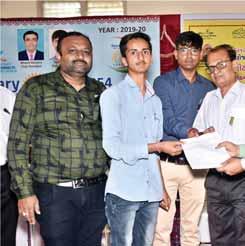
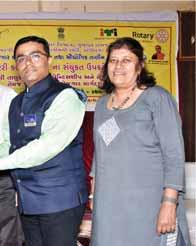
A job aspirant gets offer letter.
Chairman Akshay Mehta explained about the various activities of Rotary. The event was anchored by Rtn Pratik H Shah and a number of Rotarians
extended their support for the success of this first such job fair in Mandvi. Club Secretary Tejas Vasani gave the vote of thanks.
‘Programmes of scale’ grants are competitive grants designed to respond to a community’s needs. The grant will benefit a large number of people in a significant geographic area using a sustainable intervention with measurable outcomes and impact. Each grant will support, for three to five years, activities that align with one or more of Rotary’s areas of focus. To start the grant proposal process, use the link: https://rotaryfoundation. embark.com/auth/login
Every Rotarian, Every Year (EREY) is the fundraising initiative designed to encourage support for the Foundation’s Annual Fund. This campaign is based on the simple idea that if every Rotarian makes a personal gift every year towards Annual Fund and participate in a Foundation project, there would not be anything the Foundation couldn’t accomplish.
Every year, clubs that achieve outstanding giving in EREY, ie a minimum Annual Fund contribution of $100 per capita, with every dues-paying member giving at least $25 to
the Annual Fund are awarded with 100% Every Rotarian, Every Year Club Banner. Help your club achieve this banner in this special Centennial year of Rotary in India.
Mentioned below is the list of various club banners available to Rotary clubs for their support towards TRF during the Rotary year:
100% Foundation Giving Club
100% Every Rotarian, Every Year Club
Top three Per Capita in Annual Fund Giving
100% Paul Harris Society Club
100% Paul Harris Fellow Club (one-time recognition)
Rotary leaders can use the Club Foundation Banner Report available through My Rotary, to check their club’s status against each of the banner listed above.
The Rotarian-Digital is an absolute replica and an alternate of the print copy. The e-copy is available at half the price ($6 for six months) and can be subscribed through an email to data@rotary.org through respective Rotary club officers. Members
must have a valid email address. In places where the postal system may not be as reliable, we strongly recommend subscribing to e-copy of the monthly magazine.
“Rotary Shop”, the online platform for Rotary members to purchase Rotary produced publications and merchandise, will officially cease operations by April 2020.
While Rotary’s most popular print publications will be offered digitally through various Rotary platforms, Rotary merchandise can be purchased directly through approved licensed vendors. The list of such vendors is available through “My Rotary”. Post closure of Rotary Shop, we will no longer be taking any orders for publications or merchandise from Rotarians.
Statement about ownership and other particulars about Rotary News to be published in the first issue of every year after the last day of February
1. Place of Publication : Chennai - 600 008
2. Periodicity of its publication : Monthly
3. Printer’s Name : P T Prabhakar
Nationality : Indian Address : 15, Sivasami Street Mylapore Chennai 600 004
4. Publisher’s Name : P T Prabhakar Nationality : Indian Address : 15, Sivasami Street Mylapore Chennai 600 004
5. Editor’s Name : Rasheeda Bhagat Nationality : Indian Address : 25, Jayalakshmipuram 1st Street Nungambakkam Chennai - 600 034
6. Name and address of individual : Rotary News Trust who owns the newspaper and Dugar Towers, 3rd Floor partner or shareholders holding 34, Marshalls Road more than one percent of the Egmore total capital Chennai - 600 008
I, P T Prabhakar, declare that the particulars given are true to the best of my knowledge and belief.
Chennai - 600 008 sd/1st March, 2020 P T Prabhakar

Readers of Rotary News are familiar with the ground realities of the education system in India. They don’t need proof of its denial to thousands of less privileged; at the same time, Rotary is itself engaged in innumerable projects that make quality education accessible to children. Children like the two bright little girls featured on the cover of Grey Sunshine by Sandeep Rai, Chief of City Operations with the Teach For India (TFI) programme.

This two-year fellowship programme places young people as fulltime teachers in government classrooms across India in an effort to reform the system. So far, some 4,000 such teachers have engaged with children in government schools, impacting their lives and their futures in many positive ways. Their work has been effective enough even to power the odd child to further studies in prestigious schools/universities in the West.
Sandeep Rai, a child of Indian immigrants who opened a grocery store in the American Deep South, was on course to do medicine when he heard a sermon by preacher Keith Tonkel at the Wells Methodist Church in Jackson, Mississippi. “It is far too easy to look at those suffering and cast an eye of

Sandhya Rao
There’s nothing the children of India cannot achieve given half a chance. A recent book reminds us why we must make their education count.



judgement — to ascribe their condition to lack of hard work or a fate that’s not in their control,” Tonkel said. “But it’s much harder to accept, to remember that we are no more deserving than them. … all of us, you and me, are in desperate need of grace that is unequivocally unmerited.”
This reminder of our “desperate need of grace” motivated Rai to remain in touch with Keith and, over the next three years, think long and deep about acceptance, service, poverty, love. Then, his mind made up, he told his parents that he was no longer keen on medicine, he would join a programme called Teach For America — and that’s what he did. This life-changing decision eventually led to his moving to India and becoming part of the Teach For India family.


Grey Sunshine records Rai’s memorable journey as well as the journeys of some teachers and students. Through sober and insightful reflection, Rai shares real stories. For instance, Nishi, the daughter of a tile labourer
who migrated from Bihar, dreams of becoming a doctor. When she tells him how “Everyone looks down on lowincome people. They think we’re lazy. But that’s not true. The world doesn’t even see us as people. They stay away from us. And that perception, whether we like it or not, limits our potential,” he recognises it as a fundamental truth in India.
Readers would have heard variations on this theme everywhere as I did, from a young woman working with children in Bhopal who pointed out that “our education system is so geared towards testing failure, I’d rather pull my children out of school.” It’s in this context that Rai’s observation that “dozens of studies have shown that expectations play a crucial role in the development of children” and that “those who are held to higher standards, regardless of background or ability, almost always perform better than their counterparts” makes perfect sense.
At the other end of the spectrum you have young people like Tarun from a


middle/upper middle class background, forced to enroll in coaching centres to prepare for the IIT entrance exam. Rai recalls how Tarun, exhausted and exploited by the inhumane rigour of the system and racked by self-doubt, ran away from IIT coaching in Kota, wandered around the country, experienced real life and poverty in all its horror and humanity, and eventually went on to study in BITS Pilani before landing a job in Hindustan Lever. There he had an ‘ah’ moment and quit to become a TFI fellow so he could help children dream of becoming the best.

These young people and their wards touch the reader’s heart with their dreams and realities. They are thrown up by the vicissitudes of social and economic changes even as, sometimes, they become pawns in the hands of political forces that seek to divide people on the basis of religious belief and social stigma. The book takes us through the real battles that children and communities fight every day simply to remain afloat; the authenticity of the stories have the power to pummel the life out of every bigoted, divisive view or action by individuals posing as ‘nationalists’ and ‘reformers’ today. If they are open to reading or knowing, of course.
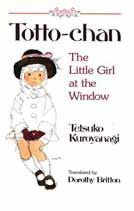
planning and coordinating one of Delhi’s first student-led conferences called I-STEP (inspiring students, teachers, educators and parents). This later snowballed into a campaign called Lakhon Mein Ek covering 100,000 villages across India. Who says young teachers and their wards cannot ask questions and find solutions?

In Anurag’s class at the Babul Uloom, a makeshift school in Seelampur, northwest Delhi, the question of quality of education comes up for discussion one day which prompts a student called Aman to ask “Actually bhaiya, what is the education level in our country?” This prompts Anurag to tell them (and us) about ASER, the Annual State of Education Report, which says that more than 50 per cent of children in Class 5 can’t read Class 2 level textbooks, and two-thirds can’t do basic subtraction and addition. When the children discover that ASER did not study the education level in Seelampur, they devise a method of collecting data and analysing it. Eventually this led to their designing,

his adult life. He has recorded his experiences teaching in New York schools and colleges in the memoir, Teacher Man (2005). Gritty yet compassionate, the book felicitously recounts the trials and frustrations and occasional successes of teaching young people growing up in strained circumstances, constantly under the threat of drugs, drinking, shooting and rank poverty.

Poor quality teaching, mismanaged schools, struggling students — they exist all over the world and many books have been written about them, some even finding success as movies. Up the Down Staircase by Bel Kaufman (1964) was 64 weeks on The NYT’s bestseller list; To Sir With Love (1959), an autobiographical novel set in London’s East End by E R Braithwaite was made into a hit film. Its title song sung by Lulu even topped the charts when I was a schoolgirl. Then there’s Totto-chan: The Little Girl at the Window (1981), an autobiographical memoir by Japanese TV personality Tetsuko Kuroyanagi about the unconventional education she received at Tomoe Takuen, an elementary school in Tokyo, during the Second World War. Incidentally, in an eerie connection to the observation made by the young woman from Bhopal, Wikipedia says the Japanese name of the book is an expression used to describe people who have failed.
The 1999 nonfiction work The Freedom Writers Diary: How a Teacher and 150 Teens Used Writing to Change Themselves and the World Around Them was written by a group of students and their teacher Erin Gruwell from Woodrow Wilson High School in California. It is based on journals the students were encouraged to keep in which they recorded the troubles of their past, present and future.

Pulitzer Prize-winning author Frank McCourt was a teacher practically all
TFI is all about the possibility of change — material, mental, emotional, social, economic and political, thanks to its founder Shaheen Mistri. After travelling with her parents to various corners of the world, this young woman settled in Mumbai. Her worldview radically changed when she saw children spending days and evenings loitering at traffic signals. After first founding the Akanksha Foundation committed to serving needy urban children, she founded Teach For India on the Teach For America fellowship model. The final words, therefore, belong to her. In Rai’s book, she writes about an imagined Museum of Grey Sunshine dedicated to educational inequity. “I yearn to visit the Museum of Grey Sunshine one day,” she writes, “to be reminded that we’ve turned the Classrooms of Oppression into Classrooms of Light. I yearn for the day the grey disappears.”
The columnist is a children’s writer and senior journalist.
Designed by Krishnapratheesh S

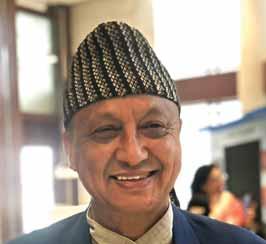


Kiran Lal Shrestha
Textile manufacturer, RC Pokhara, RID 3292
He, along with a senior Rotarian Bal Gopaldas Bhandari, installed the first Rotary club in Pokhara in 1996, inspired by the good work done by Rotarians in other parts of Nepal and the world. “Now my club has sponsored 12 clubs in Nepal,” says Kiran Lal Shrestha, adding that education, healthcare and water were the need of the hour in Pokhara at that time.
Water was a precious commodity in most of the region. “I used to see little girls carrying pots of water to their homes with their mothers in tow. We provided water facility to a village through our first matching grant and more than the villagers, we were happy to see people getting enough water in their houses.”
His most cherished moment was when a woman’s face lit up with joy as she saw water gushing from the tap. “That was our first water grant and many people discouraged us saying that we cannot see water in that village. It was a dry land. And then we dug the first borewell in Pokhara in a hospital where there was no water at all. I am inspired by my grandfather who went from Kathmandu to Pokhara to develop a water system there.”
“As for global grants, every year our district is doing 50–60 grants. This year we are aiming at 100 grants, of which 50 grant projects have been completed,” he says. This includes a cath lab, 30 dialysis centres and community water harvesting projects.
On membership, Shrestha says that the district has 17 per cent women Rotarians and he is encouraging the spouses of Rotarians to become members. “It will not only make Rotary strong, but the family stronger.” The district has 90 per cent retention in membership and will get 1,000 new members, of which 350 new members have been inducted and two new clubs out of 10 have been chartered.
The DG is encouraging new clubs in uncharted regions. “In Nepal there is a need for dialysis facilities. We told the local people that we will install a centre there if they form a club there. And a new club with 40 members has recently been formed there.”
He plans a contribution of $2.2 million to TRF, and has four donors committed to become AKS members and 150 new Major Donors.
His wife, and elder son are Rotarians and the younger son is a Rotaractor.
Ajay Agarwal
Newspaper publishing, RC Calcutta Millennium, RID 3291
He was introduced to Rotary by RIPN Shekhar Mehta. Both of them were then members of RC Central Calcutta, and “he was my IPP too,” says Ajay Agarwal.
He is excited to be the Centennial Governor in the place where Rotary India was born. “All the more exciting because all the clubs have imbibed this excitement and are very enthusiastic about doing projects. There is amazing interest in building membership, getting funds for new projects, expanding programmes with global grants, of which 50 are being applied this year,” he beams.
His most cherished moment? “Of course, when Mehta won the RI President’s assignment. When he filed his nominations, we all kept our fingers crossed and when he won, we felt very blessed, as it came when the centennial year was unfolding.”
His main focus has been on strengthening membership. Retention has been extremely good
He is a Rotarian since 1997 when he was invited by PDG K V S Anjaneya Murthy. Veerabhadra Reddy regrets not having been a Rotaractor and is making up the lost opportunity by installing 20 Rotaract clubs and 100 new Interact clubs in Visakhapatnam this year.
He is happy that his district is executing projects such as a human milk bank and two blood banks, besides global grant projects and a VTT to Nigeria. The district has done the maximum number of NCD screening camps, in response to Project Positive Health programme, he says.
Reddy has also lined up some public image events to commemorate the centennial of Rotary in India.

this year, particularly during Dec-Jan when many Rotarians leave Rotary. “We hardly saw any loss and we are trying to touch the magic figure of 4,000 this year, a goal I am confident of achieving as we are only 200 short,” says the DG.
His next goal is to do projects worth `176 crore this year. “We are on target more or less.”
His Foundation target is $400,000.
Agarwal loves visiting club projects. “They will be long-lasting memories for any governor. Fellowships come and go, but the satisfaction we get when we see projects on the ground is great. I am just coming back from a RYLA. To see young girls get trained in leadership gives me so much joy, as also water and healthcare projects.”
His wife Mamta is a past Inner Wheel All India President.
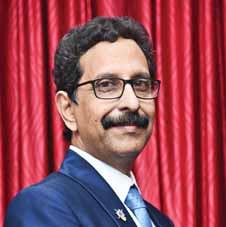
The DG is happy to have increased women’s membership which was stagnant at 180 for the last few years to 240-plus this year. He has chartered three new Rotary clubs.
On TRF giving, he is focusing on retaining the top rank held by the district in Polio Fund last year, and want to improve Annual Giving too. “Our DDF is just $15,000. It is difficult to support district projects for me or the incoming governors with such a low DDF. That’s why, this year I am focusing more on Annual Giving,” says Reddy.
Designed by N Krishnamurthy
Neena Sondhi
Former Prime Minister Inder Kumar Gujral passed away just five days before his 93 rd birthday on Dec 4, 2012. We felt we had lost a family friend. My father-in-law F C Sondhi and Avtar Narain Gujral (father of I K Gujral) struck friendship as Rotarians. In 1971–72, Sondhi as President of RC Jalandhar, 3070, visited the Nari Niketan which was run by Gujral’s parents.
After the passing away of A N Gujral, my husband P C Sondhi and
I got more involved in the working of Nari Niketan, helping Pushpa Gujral in running the institution as all her children, including I K Gujral, the eldest, were in Delhi.
Later, when his mother could no longer manage, Gujral himself got more involved in managing the institution. We had the good fortune to spend more time with him, working together in Nari Niketan.
Gujral was a humble and warmhearted personality, despite his growing status in the society. One of my
early memories is of him coming to our home, in an old, run down car, driven by his mother’s old retainer. I remember him laughing as he stepped out of the car.
Then we used to meet him sometimes in Delhi, and he always offered transport to us, which we never needed. Once I went to meet Gujral at his residence in Maharani Bagh to discuss about Nari Niketan. After our chat and tea, I was about to go, but my driver was not there. Before I could say anything, Gujral
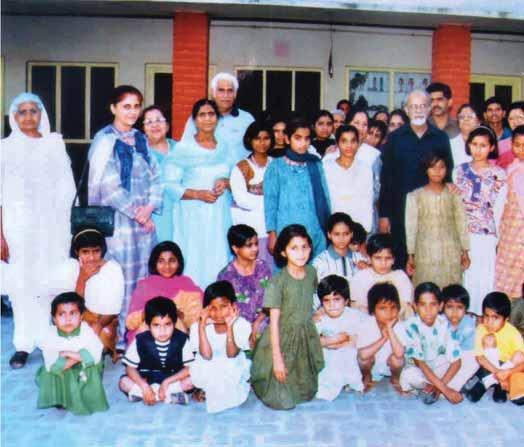

volunteered to drive his car to drop me at my house in Greater Kailash in the Capital.
In 1989, Gujral and his family were camping in Jalandhar for a month-long canvassing during the general elections. After the results were announced, one day we got a surprise visitor — Gujral himself. We were hosting a hockey customer from England as part of our family’s sports business. As we didn’t have domestic help, our two children scurried around and helped me make and serve tea to the surprise guest. The Doordarshan crew turned up at our house to interview the newly-appointed External Affairs Minister, a memorable incident that we still cherish.
In 1998, Gujral had a three-day election campaign for the Jalandhar seat. His team told me he was not visiting the industrial clusters in the city. I was disappointed and said so to Gujral when he was presiding at a Rotary meeting. Hearing my grief, he readily agreed to visit our area. In 24 hours we had to prepare the factory premises for the visit of the Indian
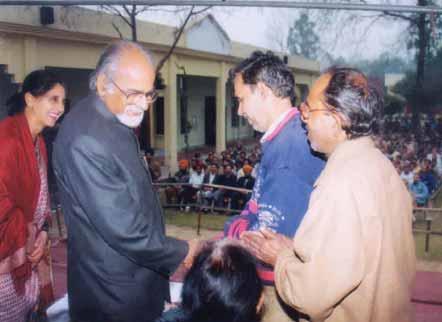
Prime Minister and his entourage. It was quite a mammoth task, but we did it happily.
After the election results, Gujral again dropped in at our house to thank us for our support. He was preceded by a busload of security personnel, and we had black cat commandos who took positions on our roof, while
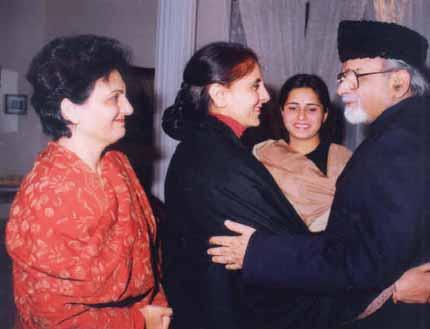
armed security men took guard outside our home. In spite of heavy security, a person managed to barge into our room to invite Gujral to a breakfast event the next day.
Once we were waiting to meet him at 5, Janpath as we had an appointment. The door opened and PRIP Rajendra Saboo came out as we were going in.
When we met Gujral a year or two before he passed away, he was not very well. However, he greeted us with the usual warmth. We talked of Nari Niketan and he expressed his gratitude for our involvement. We were about to travel to Taiwan from Delhi. On learning this was our first visit to Taiwan, he mentioned that he had enjoyed the food there when he had visited Taiwan. Finally, when we were about to go, he got up and escorted us, though slowly, to the front door, as he always did. How can one ever forget such a warmhearted and genial personality, a man of such high stature, whose was also born in 1919, the year Rotary was born in India. We pay our homage to him.
The writer is past president of RC Jalandhar South, RID 3070.
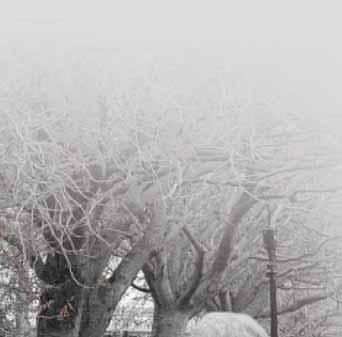
Many of us have experienced the anxiety of having to deal with an older member of the family or a friend incurring injury as a result of a fall. History of a fall among older individuals have been accepted and viewed as unavoidable accidents. But this is not necessarily so. The physical and psychological damage done as a result of the fall can be averted if proper precautions are taken.


Hip and fracture neck of femur are the most devastating, especially in older women with osteoporosis. Even if the physical injury is not debilitating, the damage to the psyche is tremendous, leading to fear and self-imposed exile from any kind of activity which in itself leads to a decrease in health and fitness. It is like a self-fulfilling prophecy — they are afraid they will fall, restrict activity, incur muscle atrophy, loss of strength and balance, and therefore fall once again when they try to get around even to navigate the most minor tasks.
— Other medical problems like Parkinson’s, diabetes, multiple sclerosis etc
— Improper footwear
— Lack of mindfulness.
Many of the above factors can be addressed by making simple modifications to the immediate environment and intervention to improve fitness levels, strength and balance.
Use antiskid tiles wherever possible. Fix railings in the bathrooms for support. Wet bathrooms are dangerous. Bathrooms must be kept dry. Steer clear of carpets that may be tripped on, sharp edges and corners, flimsy stools and chairs, wet areas, stairs without railings and poorly designed or ill-fitting footwear. Ensure good lighting and clear delineation of steps and level changes on the floor. Tables, chairs and beds should be regularly checked for stability.


Some of the most common causes of falls are:
— The immediate physical environment
— Poor fitness levels in terms of strength, balance, gait, agility and speed and reaction time
— Intake of sedating medication or anything that alters cognition
— Middle ear imbalance leading to vertigo and dizziness

Some forms of medication like sedatives, antihistamines, antihypertensives can lead to dizziness, postural hypotension and hence a tendency to lose balance. Blood sugar fluctuations while on antidiabetic medication can lead to dizziness and loss of balance.
Older individuals who have been active all their lives, participated regularly in fitness programmes and maintained
their weight within the optimum range while also maintaining optimum muscle mass have a lower incidence of falls and injury when compared to the unfit, overweight person.
An exercise programme for the elderly should include a balance and strength routine besides basic cardio.

way to increase both flexibility and balance. The twists and turns, one legged stance and inverted postures challenge the body in ways that it is not accustomed to.
“Use it or lose it”. This is the dictum for any aspect of fitness including muscle mass/strength. Deterioration is evident with disuse and sedentary living. A strength training programme that targets the major muscle groups can improve leg and hip extensor strength. This improves ability to walk easier, climb stairs, arise from a seated position in a chair or on the floor or bend to pick up something from the floor. Upper body strength, which tends to diminish rapidly due to neglect, is required to perform simple tasks like lifting, reaching and carrying. Strength training can be performed using resistance bands that are colour-coded to differentiate levels of strength, or with other forms of external weights like ankle weights, wrist bands or even dumbbells under guidance.

Large bulky muscles and enormous strength do not directly translate to great physical balance. However, weak muscles definitely render an individual more prone to falling down as a result of poor balance and the inability to support one’s own body weight properly. Movements of the body mandate a certain level of equilibrium and the ability to accommodate this shift in centre of gravity. For instance getting up from a seated position changes the centre of gravity from a lower to a higher level from the floor, thereby decreasing stability. Adequate balance and strength of leg muscles will ensure that one doesn’t tip over during the process.
Special exercises using the Bosu ball, Swiss ball, stepper when incorporated into an exercise routine can improve balance. Yoga is also a great

In order to improve balance, ensure good vision, absence of vestibular (middle ear) problems and an optimum somatosensory (sensations from hands, feet), system. This system enables the body to understand its position in relation to its environment through a sophisticated neuromuscular network. The body is constantly kept informed of its position and contact with other objects like the floor or a chair. If there is any compromise in this mechanism (and it has been found that the sensory system diminishes with age), balance may be affected.
Poor eyesight can lead to unnecessary accidents. You can miss a step or trip over a stool you did not see. The power in your eyes changes with age. Getting your vision checked regularly is important to prevent falls.
Uncontrolled diabetes can lead to poor sensation in the feet/hands. It’s important to keep feet healthy, check for blisters or non-healing ulcers. Neurological disorders such as Parkinson’s disease or multiple sclerosis will have problems with balance and the patients need to be cautioned accordingly.
Sometimes it is just sheer carelessness that creates accidents. Rushing around mindlessly, being unaware and almost unconscious of your environment can cause silly accidents that could be avoided. Mindful meditation is a great way to train the mind to stay in the present.
Simple tasks like standing on one foot for as long as possible, standing with feet as close together as possible, with heel to toe, putting on pants while standing up, walking on a straight line, getting up from a chair and walking forward, turning and coming back to sit in the chair as fast as possible can be practised to improve balance.
Specific tests are available to assess balance, strength and proprioception. Tests such as the one leg balance test, and ‘get up and go’ test, act as guidelines to structure the routine for a client. Please note that older adults with poor balance should never be allowed to exercise or perform any of these moves unsupervised.
— Be sure to include strength, balance and flexibility exercises into your routine.
— Train with a trainer who can deal with older people
— Include yoga
— Check your blood sugars


Ensure good quality, well-fitted footwear. This is the simplest and most effective step to prevent accidents. Check for wear and tear and change footwear when needed. Walking with bare feet to improve sensation in the feet is also highly recommended. Walk on different surfaces like mud, grass and sand.

— Make sure you understand the side effects of any medication you may be consuming.
— Ensure your immediate environment is free from clutter and is risk free.
— Stay mindful of your actions and movement.
The author is a lifestyle medicine physician. sheela.nambiar@gmail.com. www.drsheelanambiar.com
Designed by N Krishnamurthy
A former professor recalls meeting the legendary cartoonist who would have turned 98 on October 24.
Istill remember the day I got a peek into the office of the legendary cartoonist, R K Laxman at the Times of India building in Mumbai. The year was 1975 and I had come to meet Khushwant Singh, the famous author and the then firebrand Editor of The Illustrated Weekly of India in connection with an article I was
writing for the magazine. The door to Laxman’s office was ajar. No one was sitting at the huge colonial-style mahogany table. Out of curiosity I asked his personal assistant when he was expected and if I could get an appointment with him. I was told Laxman did not come in every day, although he sent in his cartoons daily.
Laxman’s illustrious career with The Times of India spanned over 50 years. And the kind of freedom it gave him probably suited his artistic temperament. It was many decades later that I finally got to meet Laxman, in 2000, when he was invited by the Rotary Club of Pune Riverside as the speaker for that week.
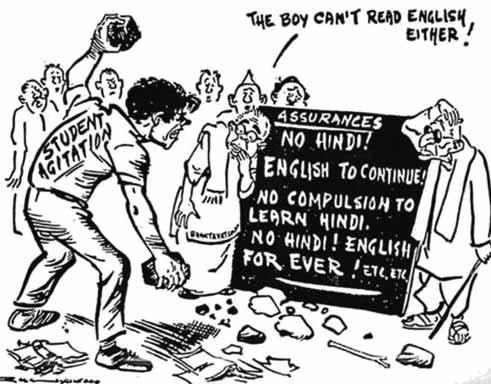
I was a club member then. In his scintillating 20-minute talk, Laxman spoke of how he had created the famous dhoti-clad, balding, reticent Common Man, with the perpetually incredulous look on his face as he observed the antics of free India’s politicians. Apparently, he had first drawn characters representing different States, but he then decided to stick to just one character who would speak for all Indians. That character, earlier known as Babuji, eventually became the Common Man.
Later that evening, a grand dinner was hosted in his honour by eminent Pune industrialist and Rotarian Nitin Desai. Everybody was excited about the chance to spend time with the celebrated cartoonist. Laxman came with his wife, Kamala, the author of the popular Tenali Rama stories. Deft strokes
A whiteboard had been placed in the wide veranda. Laxman stood beside it, marker in hand. All of us
waited eagerly for him to begin. Laxman began sketching from the top of the board. Within seconds, without once lifting his hand from the board, he had drawn Atal Bihari Vajpayee and Lalu Prasad Yadav and finally the iconic Common Man, holding a placard saying, ‘Thank you for inviting me’. His work reminded me of the craftsmen who carved the Kailash Temple from a single stone, starting at the top. Everyone burst into applause. Someone took a photograph of the
drawing. After a tete-atete, it was dinner time. We filled up our plates and drifted towards the chairs arranged in small clusters on the dimly-lit lawn. Laxman was sitting with two Rotarians. I introduced myself as a former English professor who had worked on the work of his brother
R K Narayan, among others, for my PhD. He used to illustrate his brother’s books. We talked for an hour, or rather we listened as he spoke. He was at his witty best.

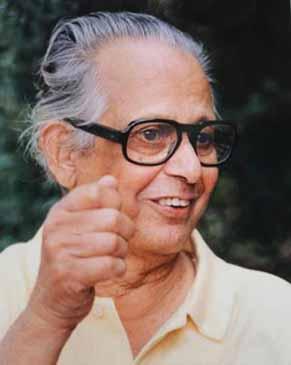
Among the stories he recounted was one about a new domestic help he and Kamala had hired. A party had been planned and a number of guests, including Bombay’s Police Commissioner, had been invited. As the guests started walking in, Kamala discovered that the new help had disappeared.
“He had overheard us saying that the Commissioner was coming,” said Laxman, laughing. “The fellow had a criminal past, we learnt later, and didn’t want to get into trouble with the police!”
The man features among the 10 hilariously idiosyncratic people Laxman wrote about in Servants of India.
Sometime later, chancing upon one of his essays in which he wrote of his art teacher in school who had
discovered his artistic talent, I called Laxman’s assistant for permission to include it in a collection of tributes I was planning on favourite teachers. Laxman readily agreed. Now, his piece, titled ‘The perfect leaf’ is part of my book, You Moved My Life: Heartwarming Stories of Teachers Who Mentored and Taught Us to Dream. Laxman finally settled in Pune, and it was here that he passed away on January 26, 2015, aged 93. The Symbiosis Institute here remembers the Common Man with a beautiful eight-feet tall bronze statue.
The author is former Professor of English, IIT-Bombay
(The article was first published in The Hindu)
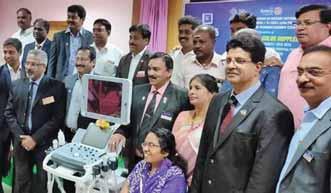
Three Rotarians — S Baskaran, U Thirunaukarasu and M Sathakathullah — trekked the Anamalai forest and gave polio drops to children of tribal families in the remote hill areas.
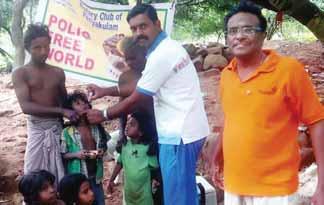
Gender-segregated toilet blocks with handwash stations were inaugurated by DG Deepak Gupta in a government school. The project was completed with a CSR grant.

A neuro scan doppler machine worth `18 lakh was donated to the Rajiv Gandhi Maternity Government Hospital. The gadget would be of immense help to monitor the health of newborns and those suffering from heart diseases. PDG S Piraiyon was present during the handover ceremony.

Over 1,000 students took part in multiple events including chess, table tennis, elocution, essay writing, drawing and poster presentation during New Generations, a themed programme. Two motivational lectures were arranged.
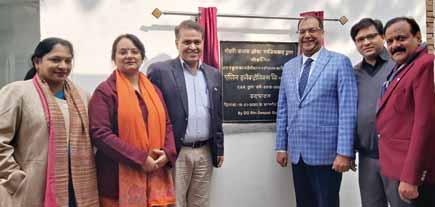
A PolioPlus campaign was held jointly with the Rural Hospital, Ballarpur. End Polio Now stickers were distributed to all the 52 booths. The club took up the campaign at busy areas such as bus terminus and railway station with teams of volunteers.

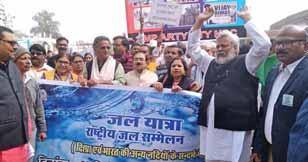
A water seminar titled Rastriya Jal Sammelan was organised with the support of other NGOs. Water conservationist Rajendra Singh was the chief guest at the event inaugurated by Vikram University Vice-Chancellor B K Sharma. A rally was taken before the seminar to create awareness on water conservation.
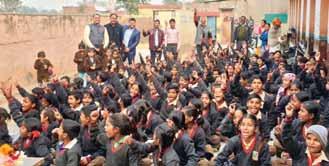
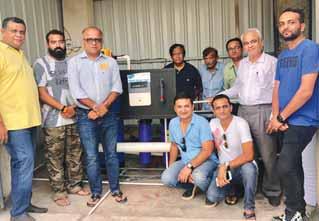
The club, in association with RC Gandevi, donated two RO plants to D E Italia Sarvajanik High School and another school in Khergam, Gujarat. More than 2,000 rural and tribal children will get safe and pure drinking water due to this project.

Shoes, blazers and sweaters were distributed to students of three government-aided schools to protect them from harsh winter. The club’s Community Service Director D K Jain and TEACH Committee Chairman Pankaj Jain organised the event.
School uniforms were distributed to 100 children at the Government Upper Primary School, Pithrody, with the support of Rotary Charitable Society. Rotarians engaged the students with inspiring speeches.
More than 800 families across 10 villages were given around 1,000 woollen blankets to keep themselves warm against the cold wave. DG Sanjay Agrawal was the chief guest at the programme. The beneficiaries included women of Jansa area on the city outskirts.
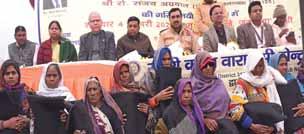
Priyadarshini
Rotary’s Four-Way Test was printed on 3,000 notebooks and distributed to Interactors at five schools. Further, Rotarians explained the importance of this thumb rule to the students who took a pledge to follow it in their everyday life.

DG Harjit Singh Talwar, along with PDG Bansi Dhurandhar and RID 3142 DG Dr Mohan Chandavarkar, presented postal stamps and covers to RI President Mark Maloney at the Centennial Summit in Kolkata. The stamps bearing Maloney’s photo were released at the district conference in Mumbai recently.


Club President Dr K V Shivaram received the Rotary WinS 1-Star Award at the district conference in Hubli, while the district got five WinS 1-Star Awards for implementing a number of hygiene projects in rural schools. PDG Ganesh Bhat, member, WinS-National Recognition Committee and DG Girish Masurkar distributed the awards.
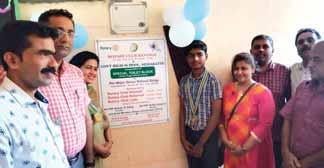
Two toilet blocks for girls and special children, along with a water purifier, were inaugurated by AG Rithesh Baliga in a joint project with three clubs in Norway, RID 2275. Rtn Tobjon Vik took the initiative and roped in 13 individuals from Norway who pooled in for the sanitation facilities.

A mega LN-4 prosthetic arm camp was held with a turnout of 365 amputees who were fitted with artificial hands. NSS volunteers from Payyanur College supported the Rotarians. DG A Karthikeyan inaugurated the camp in the presence of PDG V G Nayanar.
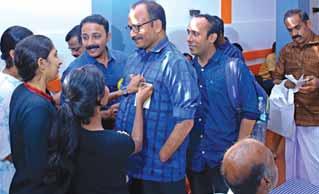
The district organised a grand Pongal celebration with a slew of cultural shows and stage programmes. Rotarians from district clubs took part in large numbers and exchanged greetings for the harvest festival. The event gave an opportunity for youngsters to showcase traditional skills.

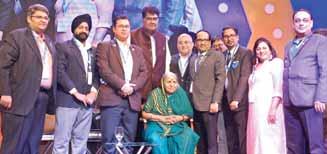
RI Director Kamal Sanghvi launched a hearse van in the presence of PDG Chandu Agarwal, Club President Ashok Agarwal and other NGOs. Former Nagaland Governor P B Acharya was also present on the occasion.
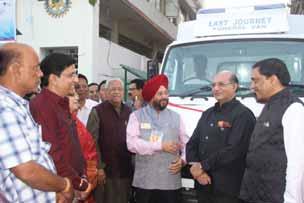
A mega medical camp was organised at Mahulia, a remote village, with Club President Dr Anup Gupta and a team of doctors led by Dr Tamal Deb screening the patients. More than 500 villagers were examined for various health issues.

An amount of `1 lakh was donated to Dr Sindhutai Sapkal, a social worker known for raising orphaned children. Sit and draw competitions for visually-challenged, thalassaemia and differently-abled children were organised.
Compiled by V Muthukumaran Designed by L Gunasekaran
You can pay the Rotary News / Rotary Samachar subscription online
Our Bank details:
Bank : HDFC Bank SB Account
Branch : Montieth Road Egmore, Chennai
A/c Name : Rotary News Trust
A/c No. : 50100213133460
IFSC Code : HDFC0003820
E mail us following details:
Name of Club
President/Secretary’s name
Amount/Date of transfer/UTR Number
For physical payment by cheque or cash in bank, write Club Name only without prefixing “Rotary club of”. Eg. Rotary Club of Delhi Central should be written: Delhi Central.
Rotary at a glance Rotarians : 1,211,107
Clubs : 35,989 Districts : 525 Rotaractors : 170,905 Clubs : 10,305 Interactors : 329,245
Clubs : 14,315
RCC : 10,900
As on Feb 14, 2020
*Please note Interact clubs that have not reported Interact Adviser in the past two Rotary years, are placed in “Suspended” status effective Oct 1, 2019.



Author : Hans Rosling (Co-authored by Ola Rosling and Anna Rosling Rönnlund)
Publisher : Sceptre
Pages : 353; `499
Whenasked simple questions about global trends — why the world’s population is increasing; how many young women go to school; how many of us live in poverty — we systematically get the answers wrong. So wrong that a chimpanzee choosing answers at random will consistently outguess journalists, Nobel laureates, and investment bankers.
In Factfulness , Professor of International Health and a man who can make data sing, Hans Rosling, together with his two long-time collaborators Anna and Ola, offers a radical new explanation of why this happens, and reveals the ten instincts that distort our perspective.
It turns out that the world, for all its imperfections, is in a much better state than we might think. But when we worry about everything all the time instead of embracing a worldview based on facts, we can lose our ability to focus on the things that threaten us most.
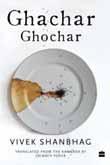

Ghachar Ghochar
Author : Vivek Shanbhag
(Translated from Kannada by Srinath Perur)
Publisher : Harper Pages : 128; ` 299
Ghochar is the Englishlanguage debut of noted Kannada writer Vivek Shanbhag’s work. The story is about how money controls the lives of a poor family. From a cramped, ant-infested house to a spacious bungalow, the family finds itself making a transition in many ways. The narrator, a sensitive young man, is numbed by the swirls around him. All he can do is flee every day to an old-world cafe, where he seeks solace from an oracular waiter. As members of the family realign their equations and desires, new strands are knotted, others come apart, and conflict brews dangerously in the background. Translated from Kannada by Srinath Perur, the book is a suspenseful, playful and ultimately menacing story about the shifting consequences of success.


Author : Ocean Vuong
Publisher : Penguin Press
Pages : 237; `1,499
Thisbook is a letter from a son to a mother who cannot read. Written when the speaker, Little Dog, is in his late 20s, the letter unearths a family’s history that began before he was born — a history whose epicentre is rooted in Vietnam — and serves as a doorway into parts of his life his mother has never known, all of it leading to an unforgettable revelation. At once a witness to the fraught yet undeniable love between a single mother and her son, it is also a brutally honest exploration of race, class and masculinity. Asking questions that are of topical relevance to American people, as they are beset with addiction, violence and trauma, but layered in words of compassion and tenderness, On Earth We’re Briefly Gorgeous is as much about the power of telling one’s own story as it is about the obliterating silence of not being heard. With stunning urgency and grace, the book focuses on people caught between disparate worlds, and asks how we heal and rescue one another without forsaking who we are. The questions of how to survive, and make it moments of joy power the most important debut novel of many years.
Compiled by Kiran Zehra Designed by Krishnapratheesh S
TCA Srinivasa Raghavan
As we get older, I find that you start to reflect on what has really mattered to you, I mean really...
Most people I talked to said parents, children, wife, teachers, books, music, all the usual things. But in my life what has mattered most are my three hairbrushes, the three loves of my life.
Hairbrushes? Yes, indeed hairbrushes. My hair is a cross between curly and straight, that is, naturally wavy. While curly hair doesn’t have to be combed and straight hair can be combed very easily, wavy hair is most troublesome. You can’t leave it as it is because it looks horrible and you can’t comb it because they just won’t settle down, no matter how much water or oil or cream or all three you use.
So as you can imagine I always had a struggle. It didn’t matter as long as I was in school but once in college, one had to appear attractive to girls. But alas throughout my BA I didn’t have any luck, either with my hair or, perhaps therefore, with girls. Both refused to cooperate.
Then came salvation, as it is wont, from out of the blue. One day while walking back from the college to my room, I found a hairbrush on the road. It looked quite new so picked it up thinking I would give it to some female classmate. I washed it thoroughly in basin with some shampoo — yes we had shampoo in the late 1960s — and
idly ran it through my hair. Then I stood transfixed in front of the mirror. My hair had suddenly settled down in dune formation. I rumpled it and tried again, to make sure. And again the result was the same.
I realised then that life had taken an important turn and decided then and there to hang on to it. It became the first love of my life. I hung on to it for the next ten years even after half its bristles had fallen off. It looked quite unwell.
But all good things must end and when I got married my wife, quickly spotted her rival. So one of the first things she did was to send my darling brush out into the dustbin. She said it looked terrible, diseased, shameful.
I sulked so she took me shopping for a brush. Nothing was good enough till I found another rival to her, in Nepal where I had gone on work. It had an intricately carved wooden handle and hard bristles, all for just Nepali `50. That was my second love, tempered this time with the knowledge that

I found a new hairbrush that was just perfect for my hair and realised then that life had taken an important turn and decided then and there to hang on to it.
I would have to make sure it lasted the rest of my life, notwithstanding wife’s tantrums.
But that was easier imagined than done. One day it just vanished. My wife said I must have forgotten it at the hotel we had stayed in. I said she must have thrown it. The mystery hasn’t been resolved in two decades.
While curly hair doesn’t have to be combed and straight hair can be combed very easily, wavy hair is most troublesome.
But you can’t keep a good man disheveled for long and soon enough I came upon my third heartthrob, this time in Korea which we were visiting. It has a carved ivory handle. I found in an antique shop. It’s small, just about four inches long. But the bristles are embedded in a copper pad and are hard like fishbone. It cost $30 but I bought it because, once again, as with my wife, it was love at first sight. The only difference is that while one makes my hair stand, the other lays it down in waves. The two complement each other perfectly. Both get into my hair.
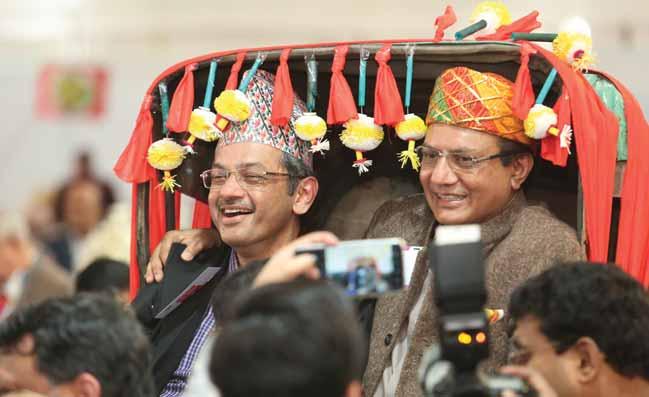


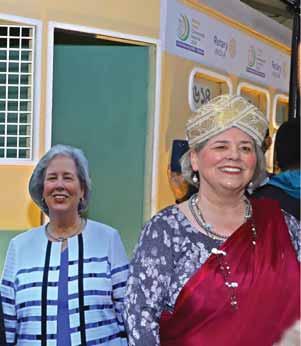

Regn. No. TN/CCN/360/2018-2020
Licensed to post WPP No.TN/PMG(CCR)/WPP-431/2018-2020
Total number of pages in this monthly issue, including cover, 84. Price: `35
Registered with Registrar of News Papers for India 3880/57 Rotary News Published on 1st of every month












